Shows
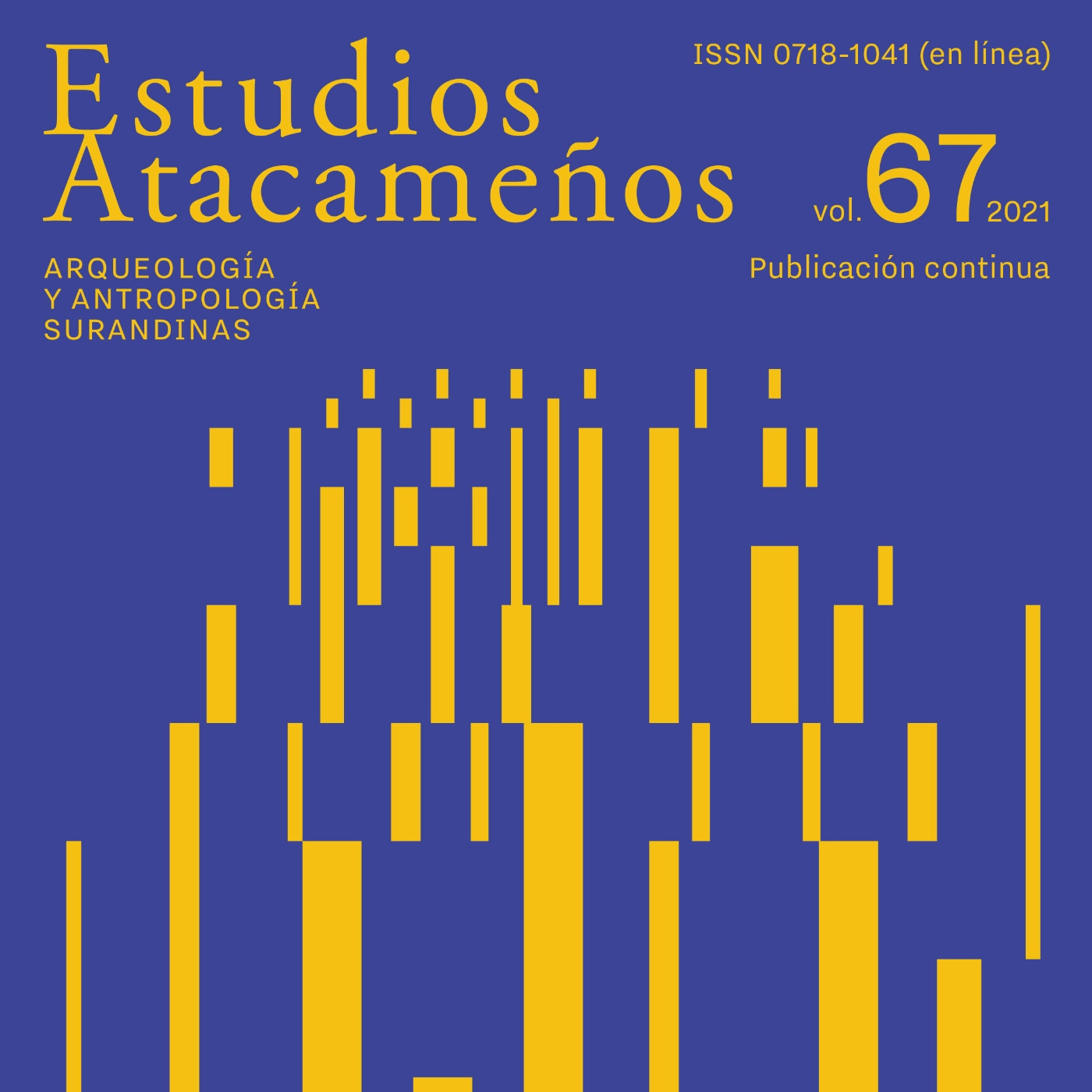 Estudios AtacameñosAn “English style” mining companyIn the mid-19th century, several mining projects were developed in the west of Catamarca province (Argentina), mainly dedicated to the exploitation of copper. In that context, the Casa Lafone stood out –among other things– for presenting itself as an “English-style” company, differentiated from the rest by the technology used and by the way in which the tasks and different aspects related to the workers' lives were organized. In this paper we seek to characterize the operation of this mining establishment by focusing on the way in which people lived, worked and circulated as a result of spatial and architectural reconfig...2022-03-1101 min
Estudios AtacameñosAn “English style” mining companyIn the mid-19th century, several mining projects were developed in the west of Catamarca province (Argentina), mainly dedicated to the exploitation of copper. In that context, the Casa Lafone stood out –among other things– for presenting itself as an “English-style” company, differentiated from the rest by the technology used and by the way in which the tasks and different aspects related to the workers' lives were organized. In this paper we seek to characterize the operation of this mining establishment by focusing on the way in which people lived, worked and circulated as a result of spatial and architectural reconfig...2022-03-1101 min Estudios AtacameñosUn Emprendimiento minero “al estilo inglés”A mediados del siglo XIX se desarrollaron varios proyectos mineros en el oeste de la provincia de Catamarca (Argentina) dedicados principalmente a la explotación de cobre. En ese contexto, la Casa Lafone se destacó –entre otras cosas– por presentarse como un emprendimiento de “estilo inglés”, diferenciado del resto por la tecnología empleada y por el modo en que se organizaban las faenas y diferentes aspectos relativos a la vida de los trabajadores. En este artículo buscamos caracterizar el funcionamiento de dicho establecimiento minero poniendo el foco en el modo en que habitaron, trabajaron y circularon las personas como...2022-03-1101 min
Estudios AtacameñosUn Emprendimiento minero “al estilo inglés”A mediados del siglo XIX se desarrollaron varios proyectos mineros en el oeste de la provincia de Catamarca (Argentina) dedicados principalmente a la explotación de cobre. En ese contexto, la Casa Lafone se destacó –entre otras cosas– por presentarse como un emprendimiento de “estilo inglés”, diferenciado del resto por la tecnología empleada y por el modo en que se organizaban las faenas y diferentes aspectos relativos a la vida de los trabajadores. En este artículo buscamos caracterizar el funcionamiento de dicho establecimiento minero poniendo el foco en el modo en que habitaron, trabajaron y circularon las personas como...2022-03-1101 min Estudios AtacameñosWeaving with the mindThis article presents the findings of an investigation about the sash named chumbe, made by the inga weavers of the Santiago-Manoy town of the upper Putumayo in Colombia. The objective of this work is to elucidate and comprehend the characteristics of the inga chumbe as cultural and mental artifact, in so far as it condenses and it’s a place of inscription of the significance nets of the inga people culture. The methodology used is qualitative. The tools applicated at the field work were semi-structured interview, the participant observation and a photographical register of the chumbe and the pictograms it co...2022-03-1101 min
Estudios AtacameñosWeaving with the mindThis article presents the findings of an investigation about the sash named chumbe, made by the inga weavers of the Santiago-Manoy town of the upper Putumayo in Colombia. The objective of this work is to elucidate and comprehend the characteristics of the inga chumbe as cultural and mental artifact, in so far as it condenses and it’s a place of inscription of the significance nets of the inga people culture. The methodology used is qualitative. The tools applicated at the field work were semi-structured interview, the participant observation and a photographical register of the chumbe and the pictograms it co...2022-03-1101 min Estudios AtacameñosTejer con la menteEste artículo presenta los hallazgos de una investigación acerca de la faja llamada chumbe elaborada por las tejedoras ingas del pueblo Santiago-Manoy del Alto Putumayo en Colombia. El objetivo de este trabajo es dilucidar y comprender las características del chumbe inga como artefacto cultural y mental, en tanto condensa y es lugar de inscripción de las redes de significación de la cultura del pueblo inga. La metodología utilizada es de tipo cualitativa. En el trabajo de campo se aplicaron herramientas como la entrevista semiestructurada, la observación participante y un registro fotodocumental del chumbe y los p...2022-03-1101 min
Estudios AtacameñosTejer con la menteEste artículo presenta los hallazgos de una investigación acerca de la faja llamada chumbe elaborada por las tejedoras ingas del pueblo Santiago-Manoy del Alto Putumayo en Colombia. El objetivo de este trabajo es dilucidar y comprender las características del chumbe inga como artefacto cultural y mental, en tanto condensa y es lugar de inscripción de las redes de significación de la cultura del pueblo inga. La metodología utilizada es de tipo cualitativa. En el trabajo de campo se aplicaron herramientas como la entrevista semiestructurada, la observación participante y un registro fotodocumental del chumbe y los p...2022-03-1101 min Estudios AtacameñosNo bossesThis article reconstructs the activity of a mining cooperative in its concrete experience in the critical juncture of 1969-1973 in Chile. Cooperative work was promoted by the State as a proposal for social transformation, but at the same time as a palliative to the high unemployment rates in the province of Atacama. He encouraged the organization of mining cooperatives, put in tension the margins of freedom displayed by the traditional pirquineros, on the one hand, and the demand for a systematic, continuous and organized effort, on the other. Difficult problem to assess among workers who exhibited a propensity to an...2022-03-1101 min
Estudios AtacameñosNo bossesThis article reconstructs the activity of a mining cooperative in its concrete experience in the critical juncture of 1969-1973 in Chile. Cooperative work was promoted by the State as a proposal for social transformation, but at the same time as a palliative to the high unemployment rates in the province of Atacama. He encouraged the organization of mining cooperatives, put in tension the margins of freedom displayed by the traditional pirquineros, on the one hand, and the demand for a systematic, continuous and organized effort, on the other. Difficult problem to assess among workers who exhibited a propensity to an...2022-03-1101 min Estudios AtacameñosSin patronesEste artículo reconstruye la actividad de una cooperativa minera en su experiencia concreta –mina Bateas– en la coyuntura crítica de 1969-1973 en Chile. El trabajo cooperativo fue impulsado desde el Estado como una propuesta de transformación social, pero al mismo tiempo como paliativo a los altos índices de cesantía en la provincia de Atacama. El estímulo a la organización de cooperativas mineras puso en tensión los márgenes de libertad desplegados por los pirquineros tradicionales, por una parte, y la demanda de un esfuerzo laboral sistemático, continuo y organizado, por otra. Problema difícil de aqu...2022-03-1101 min
Estudios AtacameñosSin patronesEste artículo reconstruye la actividad de una cooperativa minera en su experiencia concreta –mina Bateas– en la coyuntura crítica de 1969-1973 en Chile. El trabajo cooperativo fue impulsado desde el Estado como una propuesta de transformación social, pero al mismo tiempo como paliativo a los altos índices de cesantía en la provincia de Atacama. El estímulo a la organización de cooperativas mineras puso en tensión los márgenes de libertad desplegados por los pirquineros tradicionales, por una parte, y la demanda de un esfuerzo laboral sistemático, continuo y organizado, por otra. Problema difícil de aqu...2022-03-1101 min Estudios AtacameñosWheel of coplas and worlds of experience in the gorge and the eastern valleys of JujuyThe wheels of coplas in the gorge and the eastern high valleys of Jujuy are a type of song accompanied by cajas (drums), typical of the summer season. They begin with a celebration for the deceased and continue active until the funeral of the carnival. With this article I want to offer some reflections on the wheel as a creative and social activity, that "encourages" or "that drives away sadness". From my field experience, the narratives of copleras and copleros and the analysis of vernacular coplas, I will analyze the characteristics of entry into the wheel, which imply, according to...2022-03-1101 min
Estudios AtacameñosWheel of coplas and worlds of experience in the gorge and the eastern valleys of JujuyThe wheels of coplas in the gorge and the eastern high valleys of Jujuy are a type of song accompanied by cajas (drums), typical of the summer season. They begin with a celebration for the deceased and continue active until the funeral of the carnival. With this article I want to offer some reflections on the wheel as a creative and social activity, that "encourages" or "that drives away sadness". From my field experience, the narratives of copleras and copleros and the analysis of vernacular coplas, I will analyze the characteristics of entry into the wheel, which imply, according to...2022-03-1101 min Estudios AtacameñosRuedas de coplas y mundos de experiencia en la quebrada y los valles orientales de JujuyLas ruedas de coplas en la quebrada y los valles orientales de altura de Jujuy son un tipo de canto acompañado por cajas, propio de la época estival. Se inician con la celebración a los difuntos y continúan activas hasta el entierro del carnaval. Con este artículo quiero ensayar algunas reflexiones sobre la rueda en tanto actividad creativa y social, que “da ánimos” o “que aleja la tristeza”. A partir de mi experiencia de campo, de la narrativa de copleras y copleros y del análisis de coplas vernáculas, analizaré las características del ingreso a la rueda, que im...2022-03-1101 min
Estudios AtacameñosRuedas de coplas y mundos de experiencia en la quebrada y los valles orientales de JujuyLas ruedas de coplas en la quebrada y los valles orientales de altura de Jujuy son un tipo de canto acompañado por cajas, propio de la época estival. Se inician con la celebración a los difuntos y continúan activas hasta el entierro del carnaval. Con este artículo quiero ensayar algunas reflexiones sobre la rueda en tanto actividad creativa y social, que “da ánimos” o “que aleja la tristeza”. A partir de mi experiencia de campo, de la narrativa de copleras y copleros y del análisis de coplas vernáculas, analizaré las características del ingreso a la rueda, que im...2022-03-1101 min Estudios AtacameñosReligious practice, craft specialization and statusThis work presents the results of a multidisciplinary research focused on the contextual study of the grave goods of six pre-Hispanic cemeteries of the San Pedro de Atacama oasis, Antofagasta Region, Chile. The main objective was to deepen the social and ritual aspects of the prehispanic religious system in Atacama (500-1500 AD), based on the archaeological evidence of the hallucinogenic paraphernalia to elucidate the identity of the individuals carrying it and verify the hypothesis about their status as members of the Atacamenian elite. Databases with the information transcribed from the Le Paige Notes for these cemeteries served as a basic...2022-03-1102 min
Estudios AtacameñosReligious practice, craft specialization and statusThis work presents the results of a multidisciplinary research focused on the contextual study of the grave goods of six pre-Hispanic cemeteries of the San Pedro de Atacama oasis, Antofagasta Region, Chile. The main objective was to deepen the social and ritual aspects of the prehispanic religious system in Atacama (500-1500 AD), based on the archaeological evidence of the hallucinogenic paraphernalia to elucidate the identity of the individuals carrying it and verify the hypothesis about their status as members of the Atacamenian elite. Databases with the information transcribed from the Le Paige Notes for these cemeteries served as a basic...2022-03-1102 min Estudios AtacameñosPráctica religiosa, especialización artesanal y estatusEste trabajo entrega parte de los resultados de una investigación multidisciplinaria centrada en el estudio contextual de los ajuares funerarios de seis cementerios prehispánicos de los oasis de San Pedro de Atacama, región de Antofagasta, Chile. El objetivo central fue profundizar en los aspectos sociales y rituales del sistema religioso prehispánico en Atacama (500-1500 DC), tomando como base las evidencias arqueológicas de la parafernalia alucinógena para dilucidar la identidad de los individuos que la poseían, y verificar la hipótesis acerca de su condición de integrantes de la élite atacameña. Bases de datos co...2022-03-1102 min
Estudios AtacameñosPráctica religiosa, especialización artesanal y estatusEste trabajo entrega parte de los resultados de una investigación multidisciplinaria centrada en el estudio contextual de los ajuares funerarios de seis cementerios prehispánicos de los oasis de San Pedro de Atacama, región de Antofagasta, Chile. El objetivo central fue profundizar en los aspectos sociales y rituales del sistema religioso prehispánico en Atacama (500-1500 DC), tomando como base las evidencias arqueológicas de la parafernalia alucinógena para dilucidar la identidad de los individuos que la poseían, y verificar la hipótesis acerca de su condición de integrantes de la élite atacameña. Bases de datos co...2022-03-1102 min Estudios AtacameñosShepherds and farmers of SocoromaThe results of an investigation on ecological complementarity in an Aymara community located in the Sierra de Huaylillas, Arica-Parinacota Region, are presented. Based on historical research and ethnographic data, it was analyzed in diachronic perspective the ecological complementarity displayed by Socoroma’s families with aim of accessing to resources in multiples productive zones. The ethnography highlights that during the 20th century this system was characterized by a pattern of mobility and temporary residence linking the territory both intra-communal -between the different populated localities of the community space- and extra-communal -in displacements towards the coast, adjacent valleys and highlands. It is pr...2022-03-1101 min
Estudios AtacameñosShepherds and farmers of SocoromaThe results of an investigation on ecological complementarity in an Aymara community located in the Sierra de Huaylillas, Arica-Parinacota Region, are presented. Based on historical research and ethnographic data, it was analyzed in diachronic perspective the ecological complementarity displayed by Socoroma’s families with aim of accessing to resources in multiples productive zones. The ethnography highlights that during the 20th century this system was characterized by a pattern of mobility and temporary residence linking the territory both intra-communal -between the different populated localities of the community space- and extra-communal -in displacements towards the coast, adjacent valleys and highlands. It is pr...2022-03-1101 min Estudios AtacameñosPastores y agricultores de SocoromaSe presentan los resultados de una investigación sobre complementariedad ecológica en una comunidad aymara localizada en la sierra de Huaylillas, región de Arica-Parinacota. A partir de un análisis histórico e información etnográfica, se estudió en perspectiva diacrónica la complementariedad ecológica desplegada por las familias de Socoroma con el objetivo de acceder a recursos presentes en diversas zonas productivas. La etnografía destaca que durante el siglo XX este sistema se caracterizó por un patrón de movilidad y residencia temporal que ligó el territorio tanto de manera intracomunal –entre las distintas localidades pobl...2022-03-1101 min
Estudios AtacameñosPastores y agricultores de SocoromaSe presentan los resultados de una investigación sobre complementariedad ecológica en una comunidad aymara localizada en la sierra de Huaylillas, región de Arica-Parinacota. A partir de un análisis histórico e información etnográfica, se estudió en perspectiva diacrónica la complementariedad ecológica desplegada por las familias de Socoroma con el objetivo de acceder a recursos presentes en diversas zonas productivas. La etnografía destaca que durante el siglo XX este sistema se caracterizó por un patrón de movilidad y residencia temporal que ligó el territorio tanto de manera intracomunal –entre las distintas localidades pobl...2022-03-1101 min Estudios AtacameñosEarly pottery occupations. Technology and subsistence in the piedmont of northern Mendoza (West-central Argentina)Excavations carried out in an open area in the Memorial de la Bandera site in the center of the city of Mendoza (west-central Argentina) made it possible to discover, at a depth of four meters, evidence of human settlement. The diverse structures and materials found were analyzed to understand the characteristics of the occupations, their chronology, the lithic and ceramic technology, and the remains of botanical and archaeofaunal items consumed. The results obtained indicate that this occupation was developed between ca. 2100 and 1200 BP, and is one of the earliest sites and ceramic shreds found in the foothills of northern Mendoza...2022-03-1103 min
Estudios AtacameñosEarly pottery occupations. Technology and subsistence in the piedmont of northern Mendoza (West-central Argentina)Excavations carried out in an open area in the Memorial de la Bandera site in the center of the city of Mendoza (west-central Argentina) made it possible to discover, at a depth of four meters, evidence of human settlement. The diverse structures and materials found were analyzed to understand the characteristics of the occupations, their chronology, the lithic and ceramic technology, and the remains of botanical and archaeofaunal items consumed. The results obtained indicate that this occupation was developed between ca. 2100 and 1200 BP, and is one of the earliest sites and ceramic shreds found in the foothills of northern Mendoza...2022-03-1103 min Estudios AtacameñosOcupaciones alfareras tempranas. Tecnología y subsistencia en el piedemonte del norte de Mendoza (Centro Oeste...Las excavaciones en el sitio Memorial de la Bandera ubicado en la ciudad de Mendoza, faja central del Centro Oeste Argentino, permitieron recuperar evidencias del asentamiento humano en el piedemonte normendocino. Este sector contaba con escasas referencias arqueológicas debido al amplio desarrollo urbano. En este trabajo se analizan rasgos y materiales, con el objetivo de conocer las características de las ocupaciones y subsistencia en el piedemonte, su cronología y el desarrollo de la tecnología lítica y cerámica. Los fechados indican que el sitio fue ocupado entre ca. 2100 y 1200 años AP y es uno de los...2022-03-1103 min
Estudios AtacameñosOcupaciones alfareras tempranas. Tecnología y subsistencia en el piedemonte del norte de Mendoza (Centro Oeste...Las excavaciones en el sitio Memorial de la Bandera ubicado en la ciudad de Mendoza, faja central del Centro Oeste Argentino, permitieron recuperar evidencias del asentamiento humano en el piedemonte normendocino. Este sector contaba con escasas referencias arqueológicas debido al amplio desarrollo urbano. En este trabajo se analizan rasgos y materiales, con el objetivo de conocer las características de las ocupaciones y subsistencia en el piedemonte, su cronología y el desarrollo de la tecnología lítica y cerámica. Los fechados indican que el sitio fue ocupado entre ca. 2100 y 1200 años AP y es uno de los...2022-03-1103 min Estudios AtacameñosMyths and rituals around water in the andean community of CullhuayThe analysis of myths and rituals helps us understand the meaning that water acquires for local Andean populations in a context shaped by profound socio-environmental transformations. In this text we are interested in analyzing some of the myths and rituals related to water in the Andean community of Cullhuay, integrated –as part of the community– to water in its multiple forms, and whose importance transcends the merely monetary value. This understanding clashes with the technocratic discourses which impose new narratives, and with it, new forms of management from which the discursive and material expropriation of this central resource is legitimized for...2022-03-1101 min
Estudios AtacameñosMyths and rituals around water in the andean community of CullhuayThe analysis of myths and rituals helps us understand the meaning that water acquires for local Andean populations in a context shaped by profound socio-environmental transformations. In this text we are interested in analyzing some of the myths and rituals related to water in the Andean community of Cullhuay, integrated –as part of the community– to water in its multiple forms, and whose importance transcends the merely monetary value. This understanding clashes with the technocratic discourses which impose new narratives, and with it, new forms of management from which the discursive and material expropriation of this central resource is legitimized for...2022-03-1101 min Estudios AtacameñosMitos y rituales en torno al agua en la comunidad andina de CullhuayEl análisis de los mitos y rituales nos ayuda a comprender la significación que adquiere el agua para las poblaciones locales andinas, en un contexto marcado por transformaciones socioambientales profundas. En este texto nos interesa analizar algunos de los mitos y rituales de la comunidad andina de Cullhuay, que integra –como parte de la comunidad– al agua en sus múltiples formas, y cuya importancia trasciende el valor meramente monetario. Esta concepción se confronta con los discursos tecnocráticos que imponen nuevas narrativas y, con ello, nuevas formas de gestión a partir de las cuales se legitima l...2022-03-1101 min
Estudios AtacameñosMitos y rituales en torno al agua en la comunidad andina de CullhuayEl análisis de los mitos y rituales nos ayuda a comprender la significación que adquiere el agua para las poblaciones locales andinas, en un contexto marcado por transformaciones socioambientales profundas. En este texto nos interesa analizar algunos de los mitos y rituales de la comunidad andina de Cullhuay, que integra –como parte de la comunidad– al agua en sus múltiples formas, y cuya importancia trasciende el valor meramente monetario. Esta concepción se confronta con los discursos tecnocráticos que imponen nuevas narrativas y, con ello, nuevas formas de gestión a partir de las cuales se legitima l...2022-03-1101 min Estudios AtacameñosPre-Columbian Mining and metallurgy in the Argentinean NorthwestThis paper synthetizes what we know so far about pre-Columbian mining and metallurgical activities, during pre-Inka and Inka times, in the present-day territory of Jujuy province (Argentina). To do so, we analyze the extractive and productive contexts that we and other scholars have studied in the three eco-regions of the province, in order to identify the direct and indirect evidences of mining, smelting and manufacture of metal objects. Based on the results, we state that despite the availability of metalliferous minerals in the province, the pre-Columbian mining activities have not reached a large scale, neither in extent nor in intensity...2022-03-1102 min
Estudios AtacameñosPre-Columbian Mining and metallurgy in the Argentinean NorthwestThis paper synthetizes what we know so far about pre-Columbian mining and metallurgical activities, during pre-Inka and Inka times, in the present-day territory of Jujuy province (Argentina). To do so, we analyze the extractive and productive contexts that we and other scholars have studied in the three eco-regions of the province, in order to identify the direct and indirect evidences of mining, smelting and manufacture of metal objects. Based on the results, we state that despite the availability of metalliferous minerals in the province, the pre-Columbian mining activities have not reached a large scale, neither in extent nor in intensity...2022-03-1102 min Estudios AtacameñosMinería y metalurgia prehispánica en el Noroeste ArgentinoPresentamos una síntesis de lo que conocemos hasta el momento sobre las actividades mineras y metalúrgicas prehispánicas desarrolladas en el territorio de la actual provincia de Jujuy (Argentina). Para ello, se analizan los contextos extractivos y productivos estudiados por nosotros y por otros investigadores en las tres ecorregiones de la provincia, y se identifican las evidencias mineras directas e indirectas, y los indicadores de fundición y manufactura de objetos metálicos. Sobre la base de los resultados alcanzados se afirma que más allá de la disponibilidad de minerales metalíferos en la provincia, las actividades mineras...2022-03-1102 min
Estudios AtacameñosMinería y metalurgia prehispánica en el Noroeste ArgentinoPresentamos una síntesis de lo que conocemos hasta el momento sobre las actividades mineras y metalúrgicas prehispánicas desarrolladas en el territorio de la actual provincia de Jujuy (Argentina). Para ello, se analizan los contextos extractivos y productivos estudiados por nosotros y por otros investigadores en las tres ecorregiones de la provincia, y se identifican las evidencias mineras directas e indirectas, y los indicadores de fundición y manufactura de objetos metálicos. Sobre la base de los resultados alcanzados se afirma que más allá de la disponibilidad de minerales metalíferos en la provincia, las actividades mineras...2022-03-1102 min Estudios AtacameñosBeyond the message of salvationThe paper compares two periods in the history of a Quechua community (Amantaní Island, Titicaca Lake, Perú). They were moments of social conflict, in which the Seventh-day Adventist Church played a significant role. At each moment, different indigenous sectors, with different interests, and political and economic objectives, showed greater predisposition to religious change. This demonstrates the strategic nature of the conversion. But religious change was not necessarily a conscious strategy. The islanders do not notice the relationship between interests and the option of faith. Bourdieu's constructivist theory allows us to understand how the conversion coherently fits the objectives of each so...2022-03-1101 min
Estudios AtacameñosBeyond the message of salvationThe paper compares two periods in the history of a Quechua community (Amantaní Island, Titicaca Lake, Perú). They were moments of social conflict, in which the Seventh-day Adventist Church played a significant role. At each moment, different indigenous sectors, with different interests, and political and economic objectives, showed greater predisposition to religious change. This demonstrates the strategic nature of the conversion. But religious change was not necessarily a conscious strategy. The islanders do not notice the relationship between interests and the option of faith. Bourdieu's constructivist theory allows us to understand how the conversion coherently fits the objectives of each so...2022-03-1101 min Estudios AtacameñosMás allá del mensaje de salvaciónEl artículo compara dos períodos en la historia de una comunidad quechua (isla de Amantaní, lago Titicaca, Perú). Fueron momentos de conflicto social, en los que la Iglesia Adventista del Séptimo Día jugó un papel significativo. En cada momento, distintos sectores indígenas, con determinados intereses y objetivos políticos y económicos, mostraron mayor predisposición al cambio religioso. Esto demuestra el carácter estratégico de la conversión. Pero el cambio religioso no fue necesariamente una estrategia consciente. Los isleños no advierten la relación entre intereses y opción de fe. La teoría constru...2022-03-1101 min
Estudios AtacameñosMás allá del mensaje de salvaciónEl artículo compara dos períodos en la historia de una comunidad quechua (isla de Amantaní, lago Titicaca, Perú). Fueron momentos de conflicto social, en los que la Iglesia Adventista del Séptimo Día jugó un papel significativo. En cada momento, distintos sectores indígenas, con determinados intereses y objetivos políticos y económicos, mostraron mayor predisposición al cambio religioso. Esto demuestra el carácter estratégico de la conversión. Pero el cambio religioso no fue necesariamente una estrategia consciente. Los isleños no advierten la relación entre intereses y opción de fe. La teoría constru...2022-03-1101 min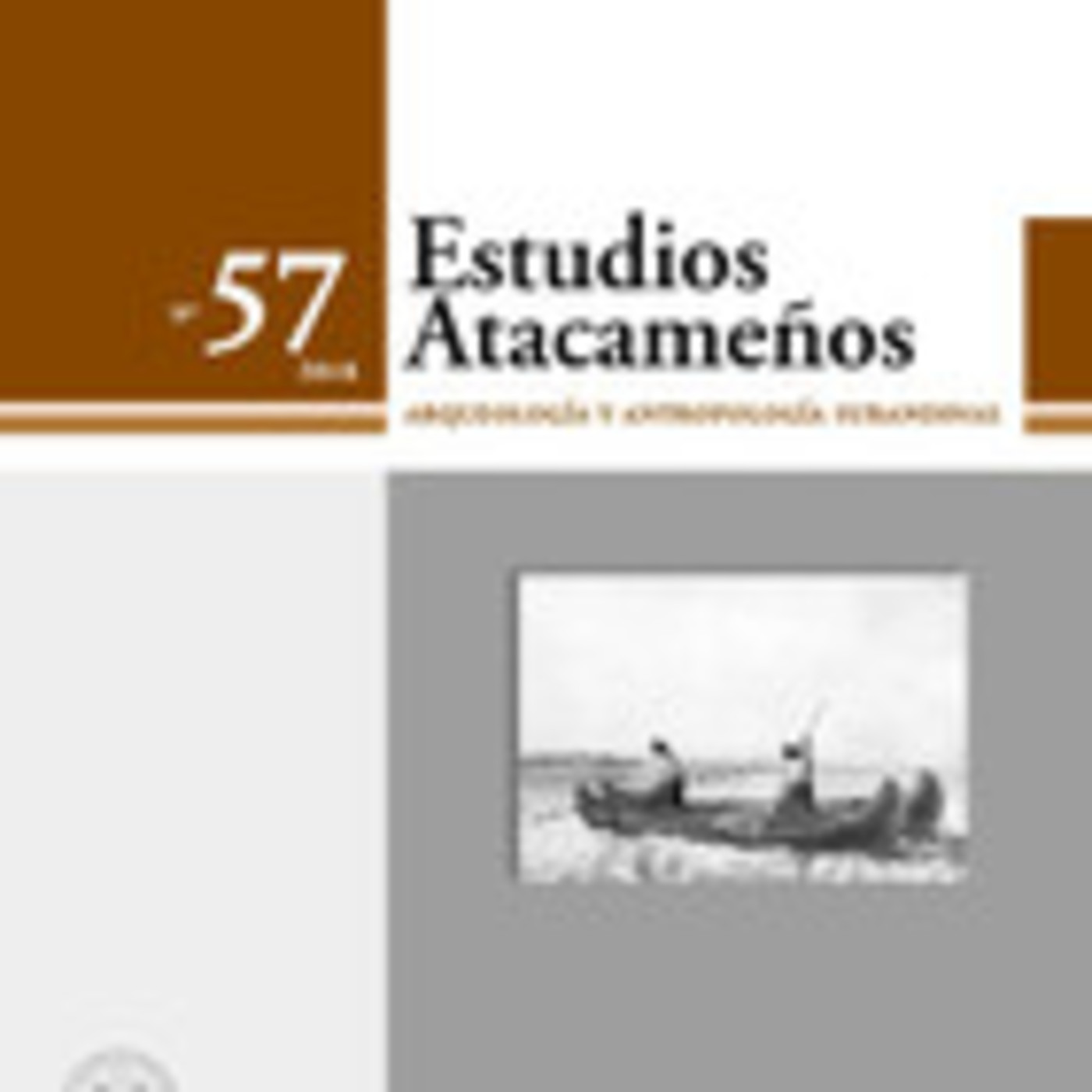 Estudios AtacameñosDental caries and oral health in colonial populations of Mendoza (Argentina) during the XVIII-XIX centuries.Authors: P. Sebastián Giannotti, Daniela A. Mansegosa, Horacio D. Chiavazza.
This work studies the presence of dental caries in a sample of adult skeletons recovered from excavations carried out in the colonial temple of San Francisco-La Caridad (18th-19th centuries) in the Foundational Area of Mendoza (Argentina). Frequency, distribution and location of carious lesions in the anterior and posterior dentition of two sub-samples (teeth of primary and secondary burials) are evaluated. Each subsample could correspond to social sectors with different status. The prevalence of caries was similar among social groups, although some differences in the distribution and location of t...2019-01-2401 min
Estudios AtacameñosDental caries and oral health in colonial populations of Mendoza (Argentina) during the XVIII-XIX centuries.Authors: P. Sebastián Giannotti, Daniela A. Mansegosa, Horacio D. Chiavazza.
This work studies the presence of dental caries in a sample of adult skeletons recovered from excavations carried out in the colonial temple of San Francisco-La Caridad (18th-19th centuries) in the Foundational Area of Mendoza (Argentina). Frequency, distribution and location of carious lesions in the anterior and posterior dentition of two sub-samples (teeth of primary and secondary burials) are evaluated. Each subsample could correspond to social sectors with different status. The prevalence of caries was similar among social groups, although some differences in the distribution and location of t...2019-01-2401 min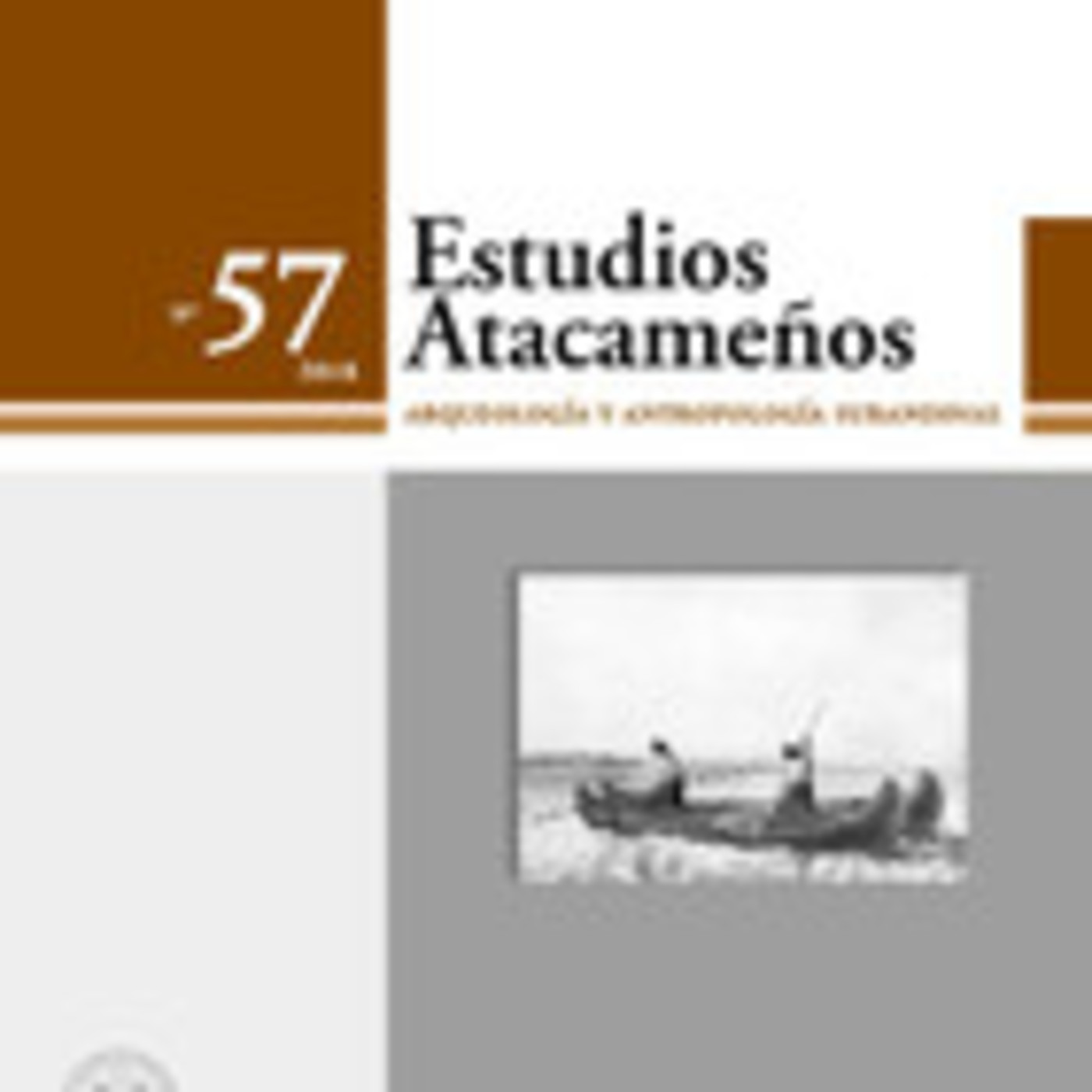 Estudios AtacameñosUnequal opportunities: companies and the State in contention over mining in Chile.Author: Bettina Schorr.
This article examines significant variations between two conf licts over mining in Chile regarding the degree, the scale and the outcomes of contention: the conf licts in Chañaral where the public company Codelco operates and in the Huasco Valley (Pascua Lama) where a transnational company is in charge. While the former suffers widespread contamination caused by mining activities, opposition against mining remains low and isolated and the state barely responds to local claims. In contrast, the mining project of Pascua Lama motivated large-scale protests, reached national and international support and managed that state agencies partly acted o...2019-01-2401 min
Estudios AtacameñosUnequal opportunities: companies and the State in contention over mining in Chile.Author: Bettina Schorr.
This article examines significant variations between two conf licts over mining in Chile regarding the degree, the scale and the outcomes of contention: the conf licts in Chañaral where the public company Codelco operates and in the Huasco Valley (Pascua Lama) where a transnational company is in charge. While the former suffers widespread contamination caused by mining activities, opposition against mining remains low and isolated and the state barely responds to local claims. In contrast, the mining project of Pascua Lama motivated large-scale protests, reached national and international support and managed that state agencies partly acted o...2019-01-2401 min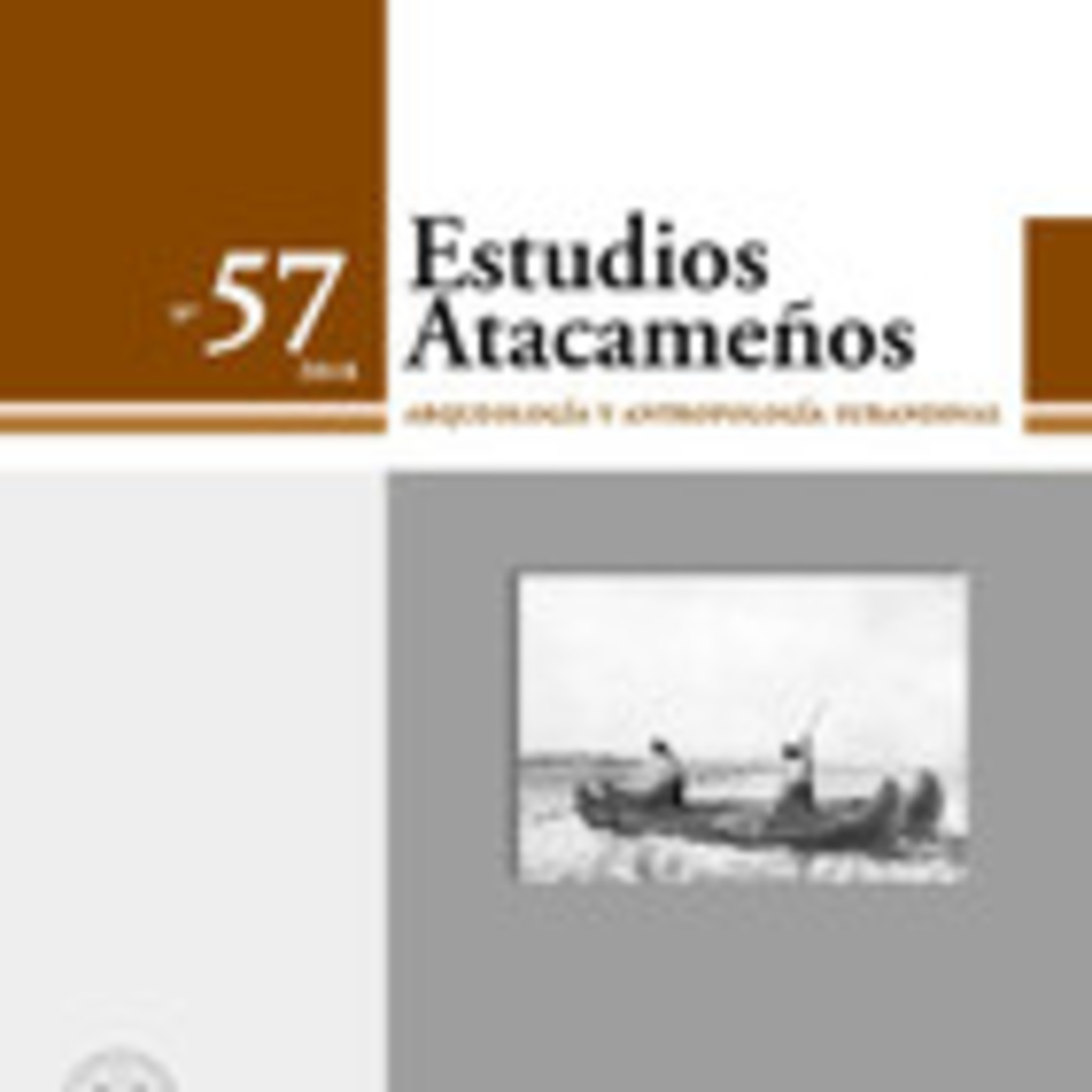 Estudios AtacameñosArica: a City Among Three Borders.Author: Haroldo Dilla Alfonso.
Arica is part of a dense socio-historical skein that form the Chilean borders, but distinguished by the particular intensity and diversity of its fields and circuits of cross-borders relationships. Its reality as a transborder region – molded by the actions from communities, markets and states – is a peculiar interweaving of its relations with its three land borders: Bolivia, Peru and Tarapacá. And with its port, that connect the region with the Pacific Ocean and the Asian economy. This article discusses the characteristics of each one of them, the way they relate to create a distinguishable territory and the c...2019-01-2400 min
Estudios AtacameñosArica: a City Among Three Borders.Author: Haroldo Dilla Alfonso.
Arica is part of a dense socio-historical skein that form the Chilean borders, but distinguished by the particular intensity and diversity of its fields and circuits of cross-borders relationships. Its reality as a transborder region – molded by the actions from communities, markets and states – is a peculiar interweaving of its relations with its three land borders: Bolivia, Peru and Tarapacá. And with its port, that connect the region with the Pacific Ocean and the Asian economy. This article discusses the characteristics of each one of them, the way they relate to create a distinguishable territory and the c...2019-01-2400 min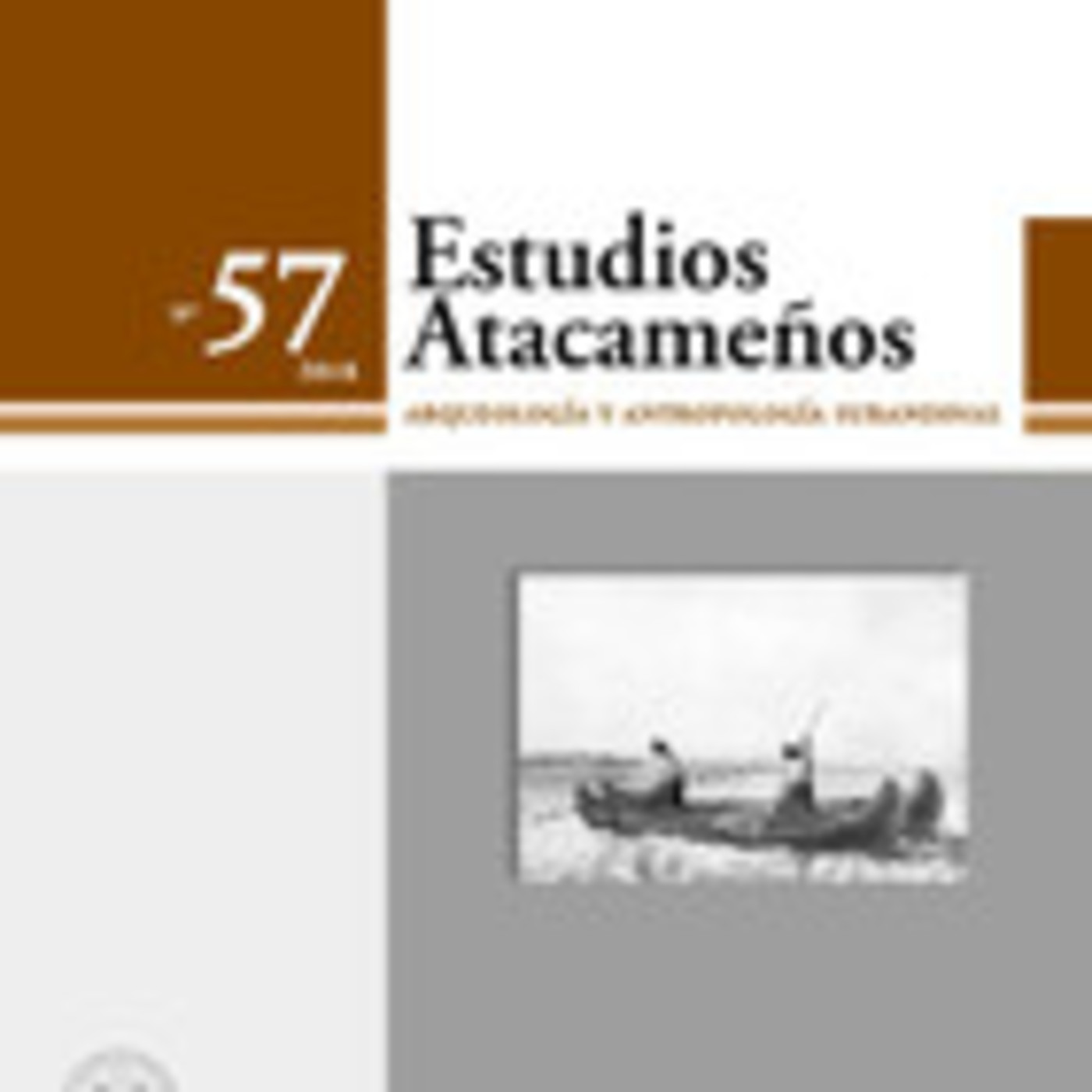 Estudios AtacameñosRedskins at La Tirana Festivity: The Aniceto Palza Dance.Author: Bernardo Guerrero Jiménez.
At the present article the origin and development of a religious association that is introduced in La Tirana festivity in 1938 called “pieles rojas” is analyzed. It is interpreted based upon varied categories such as adaptation, translation and appropriation. Also it includes the reason why the Redskins have been included in a religious and popular festivity settled at Atacama desert. It is stated that the presence of the dancing group “chuncho” can be regarded as a previous step to the formation of this north american dancing group. We emphasize in the creative personality of the funder: Aniceto P...2019-01-2400 min
Estudios AtacameñosRedskins at La Tirana Festivity: The Aniceto Palza Dance.Author: Bernardo Guerrero Jiménez.
At the present article the origin and development of a religious association that is introduced in La Tirana festivity in 1938 called “pieles rojas” is analyzed. It is interpreted based upon varied categories such as adaptation, translation and appropriation. Also it includes the reason why the Redskins have been included in a religious and popular festivity settled at Atacama desert. It is stated that the presence of the dancing group “chuncho” can be regarded as a previous step to the formation of this north american dancing group. We emphasize in the creative personality of the funder: Aniceto P...2019-01-2400 min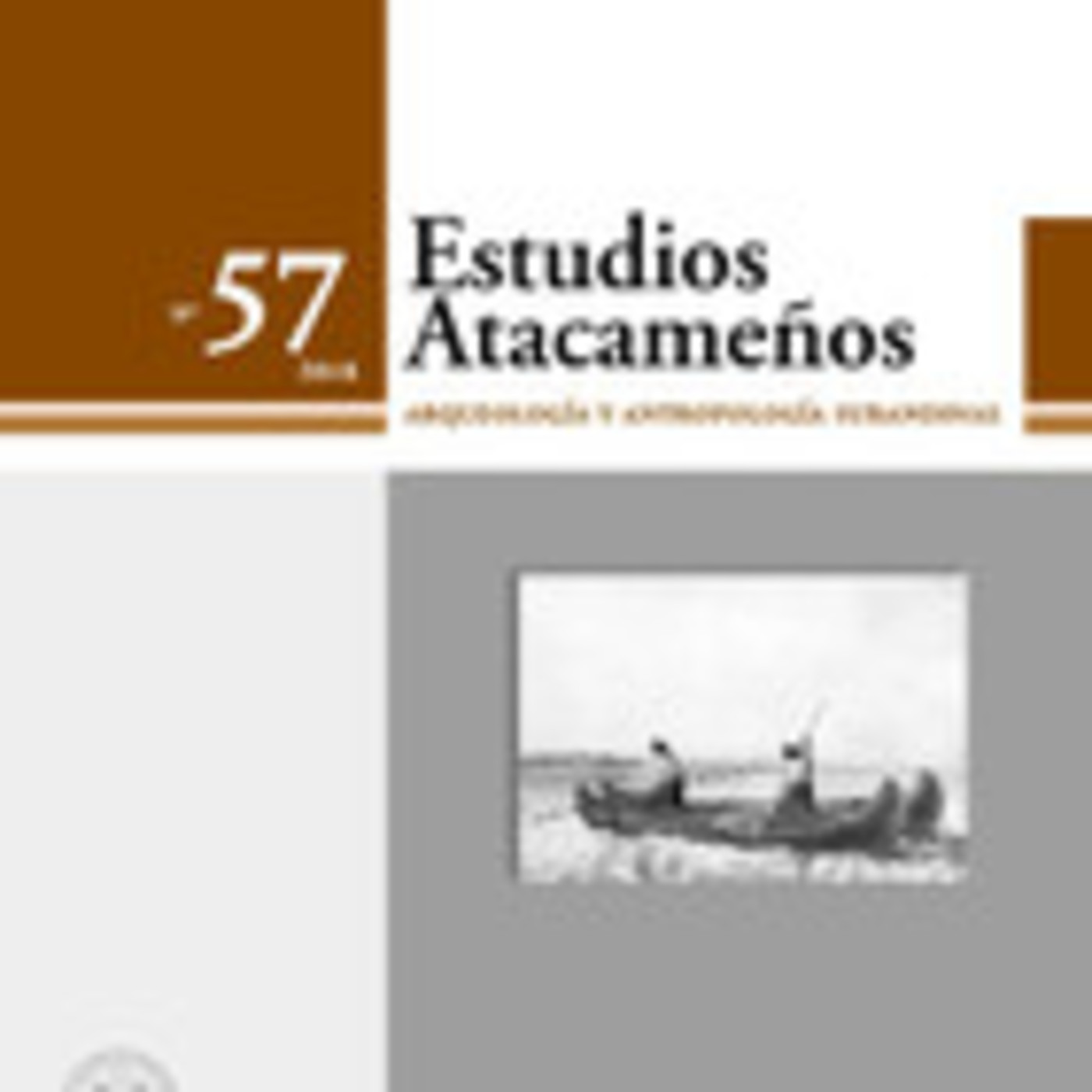 Estudios AtacameñosStrategies and inclusion practices of migrant students in Arica and Parinacota schools, northern border of Chile.Authors: Carlos Mondaca, Wilson Muñoz, Yeliza Gajardo, Joaquín Gairín.
The aim of this article is to describe and characterize the strategies and sociocultural insertion practices in migrant students (Peruvians and Bolivians) in schools located in the Arica and Parinacota region, Northern Chile. It is analyzed how the formal educational system has not developed institutional mechanisms of sociocultural integration that allow an appropiate insertion to foreign students in chilean schools, whereby, different social agents (students, parents and representatives) have had to display strategies and specific insertion practices adapted to the local context, generating emerging mechanisms of sociocultural integration.2019-01-2401 min
Estudios AtacameñosStrategies and inclusion practices of migrant students in Arica and Parinacota schools, northern border of Chile.Authors: Carlos Mondaca, Wilson Muñoz, Yeliza Gajardo, Joaquín Gairín.
The aim of this article is to describe and characterize the strategies and sociocultural insertion practices in migrant students (Peruvians and Bolivians) in schools located in the Arica and Parinacota region, Northern Chile. It is analyzed how the formal educational system has not developed institutional mechanisms of sociocultural integration that allow an appropiate insertion to foreign students in chilean schools, whereby, different social agents (students, parents and representatives) have had to display strategies and specific insertion practices adapted to the local context, generating emerging mechanisms of sociocultural integration.2019-01-2401 min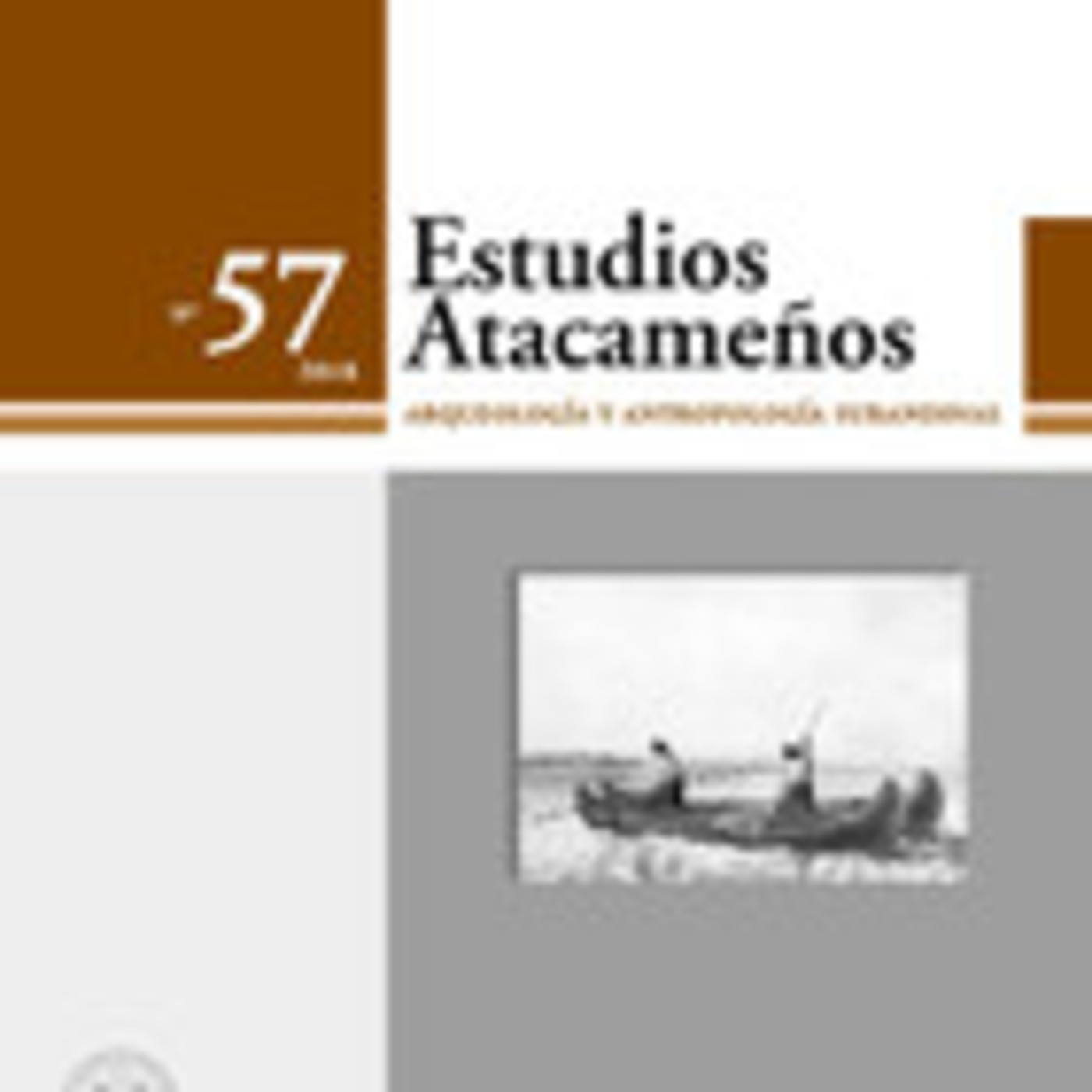 Estudios AtacameñosEthnicity and social relationships in Atacameño space.Authors: Hans Gundermann, Héctor González, John Durston.
This paper deals with the issue of ethnic identity and alterity relationships’ configuration in contemporary social space in the Atacama Region, Chile. After an historical review of the relationships between the most important groups in this space, collective identities and alterity outlines are described and analyzed, to determinate the incidence of this process in the constitution of the spaces of social interaction, specially economical and social ones, where the members of this groups are involved. In those spaces, relationships underlying the social inequalities, stereotypes and prejudges, coexistence and rivality, besides opposition and...2019-01-2400 min
Estudios AtacameñosEthnicity and social relationships in Atacameño space.Authors: Hans Gundermann, Héctor González, John Durston.
This paper deals with the issue of ethnic identity and alterity relationships’ configuration in contemporary social space in the Atacama Region, Chile. After an historical review of the relationships between the most important groups in this space, collective identities and alterity outlines are described and analyzed, to determinate the incidence of this process in the constitution of the spaces of social interaction, specially economical and social ones, where the members of this groups are involved. In those spaces, relationships underlying the social inequalities, stereotypes and prejudges, coexistence and rivality, besides opposition and...2019-01-2400 min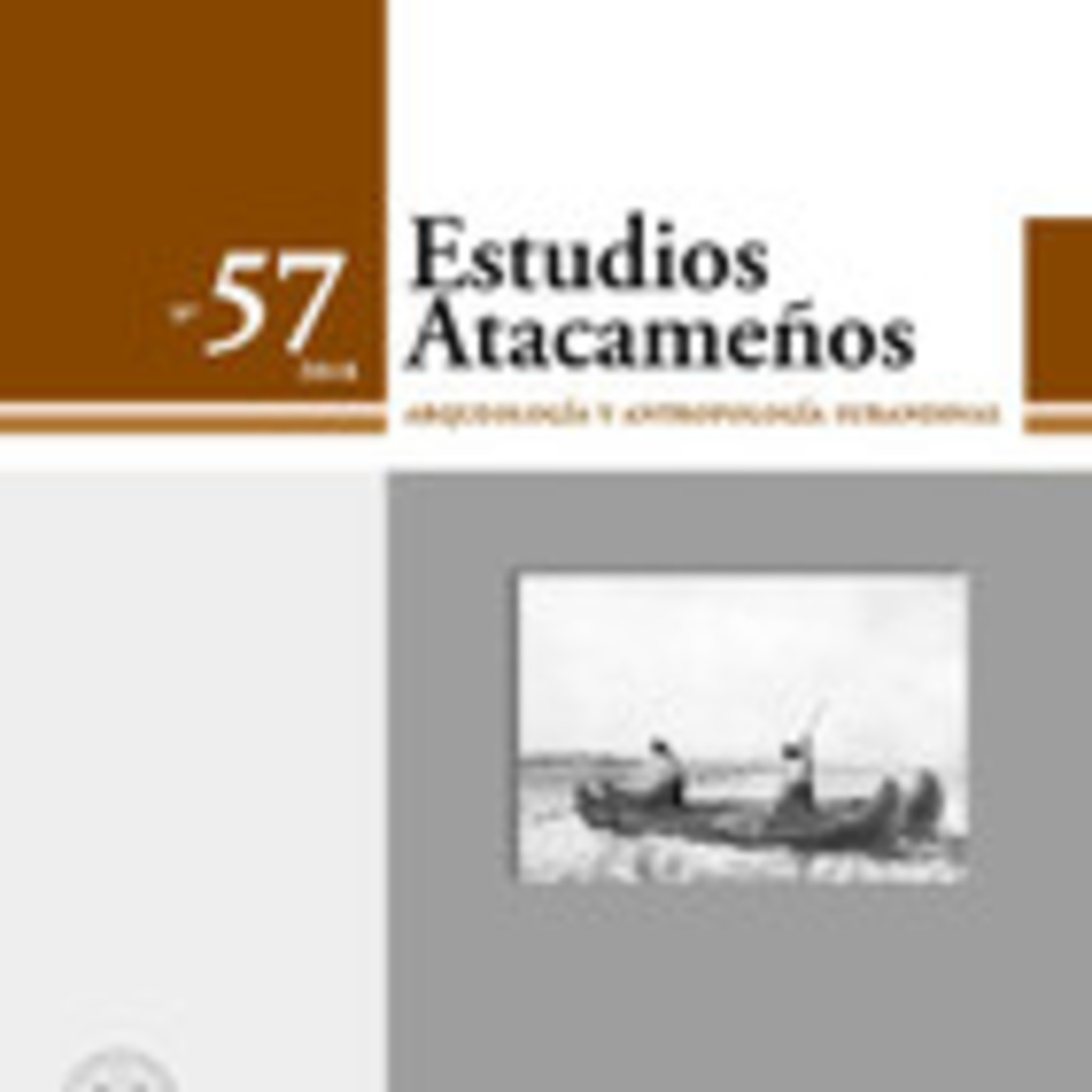 Estudios AtacameñosThe Santos Guayama’s lost republic. Indigenous demands and montonero rebellions in Argentina, XIX century.Author:
Diego Escolar.
Centered in the caudillo Santos Guayama, this article analyses the impact of indigenous political traditions on the federalist rebelions in the Argentinean west between 1860 and 1870 decades. The Argentinean historiography doesn’t consider the significance of ethnic experiences as factors of political movilization during this period. But recent documental findings on Guanacache area, at the core of theregion, suggest the close relationship of these conflicts with political indigenous traditions of land struggle from ancient reductions.2019-01-2400 min
Estudios AtacameñosThe Santos Guayama’s lost republic. Indigenous demands and montonero rebellions in Argentina, XIX century.Author:
Diego Escolar.
Centered in the caudillo Santos Guayama, this article analyses the impact of indigenous political traditions on the federalist rebelions in the Argentinean west between 1860 and 1870 decades. The Argentinean historiography doesn’t consider the significance of ethnic experiences as factors of political movilization during this period. But recent documental findings on Guanacache area, at the core of theregion, suggest the close relationship of these conflicts with political indigenous traditions of land struggle from ancient reductions.2019-01-2400 min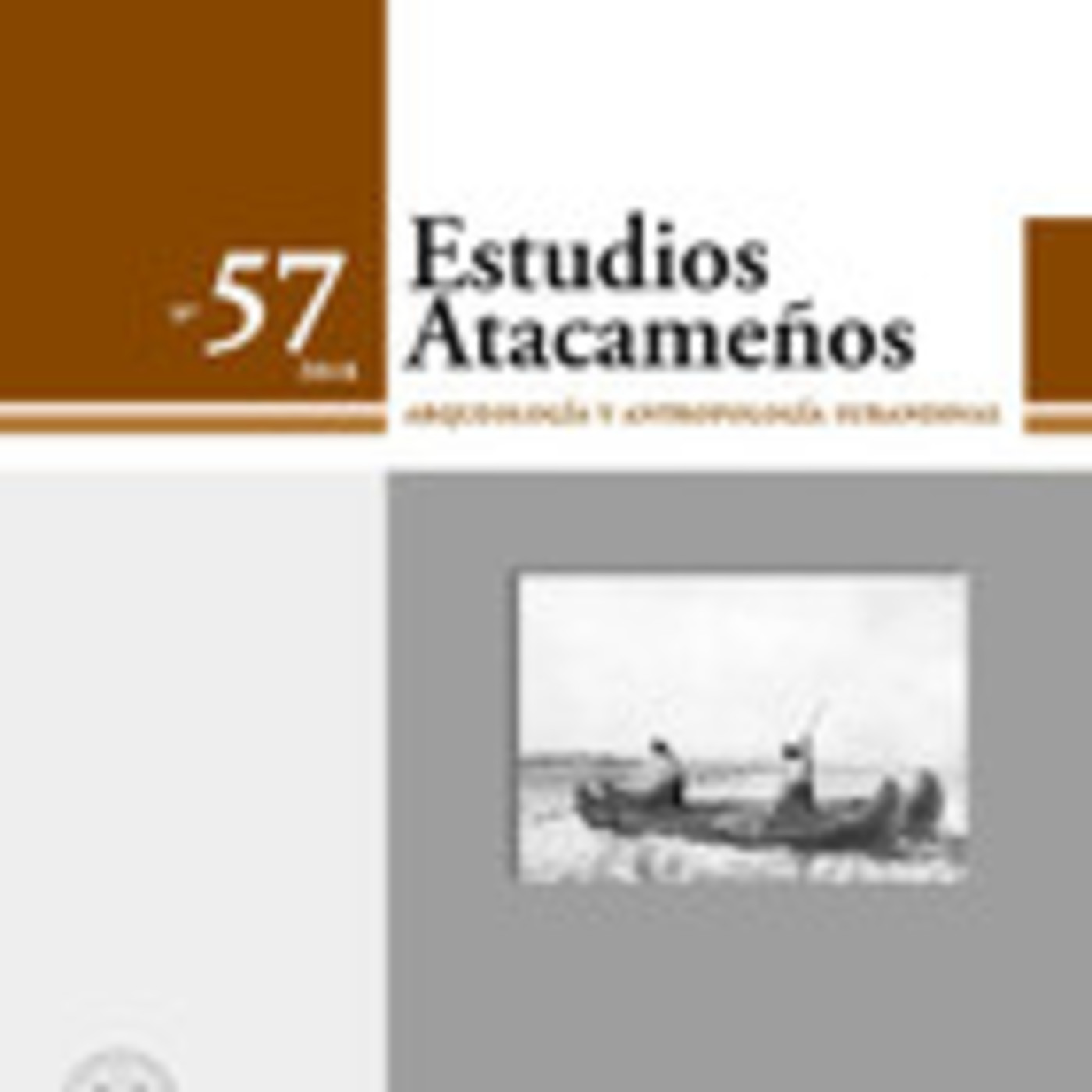 Estudios AtacameñosIndustrial solar energy at Atacama Desert between 1933 to 1952: Research, development and sustainability.Author: Nelson Arellano-Escudero
A business archive analysis allows knowing the process of research and developmentin the saltpeter industry in the middle of the XX century and the incorporation of the use of Solar Energy to its production processes. The study of this case discusses the evolution of technology and the theses of innovation analyzing an industrial history. The analytical course of the case of the Coya Sur solar ponds seeks tounderstand a viable alternative to hegemonic technologies by presenting new antecedents of the history of technology and its possible impact on the sustainability problem.2019-01-2400 min
Estudios AtacameñosIndustrial solar energy at Atacama Desert between 1933 to 1952: Research, development and sustainability.Author: Nelson Arellano-Escudero
A business archive analysis allows knowing the process of research and developmentin the saltpeter industry in the middle of the XX century and the incorporation of the use of Solar Energy to its production processes. The study of this case discusses the evolution of technology and the theses of innovation analyzing an industrial history. The analytical course of the case of the Coya Sur solar ponds seeks tounderstand a viable alternative to hegemonic technologies by presenting new antecedents of the history of technology and its possible impact on the sustainability problem.2019-01-2400 min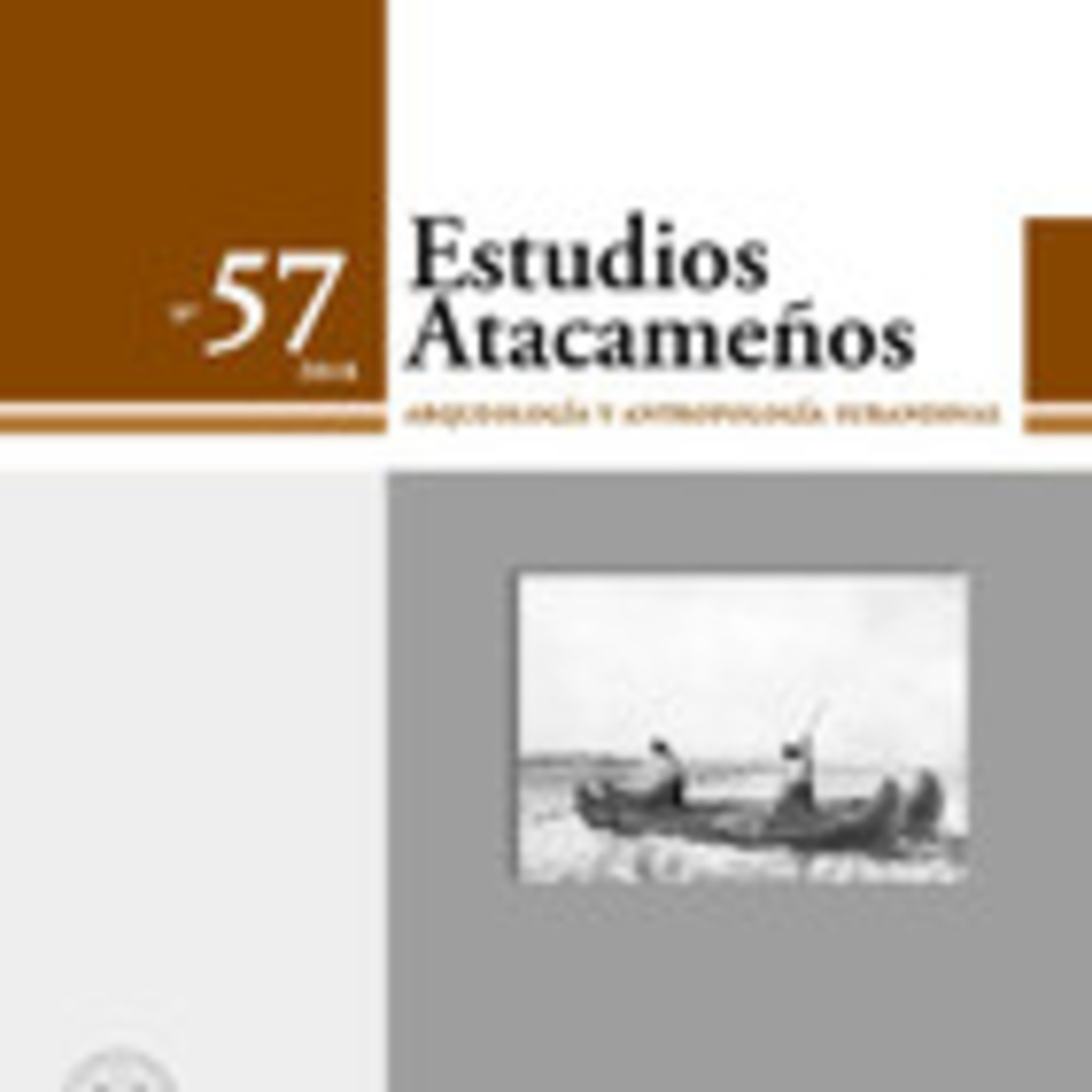 Estudios AtacameñosChamantos, ponchos and Balandres in Colchagua and Rancagua (XVII-XIX centuries).Authors: Pablo Lacoste, Michelle Malén Lacoste Adunka.
We study the history of ponchos, balandres and chamantos from notary and judicial sources of Colchagua and Rancagua, from the early seventeenth century to the midnineteenthcentury. This source provides relevant knowledge about the presence ofthese tissues in chilean society, its social and economic value, its historical cycles andits color characteristics. It demonstrates the deep rootedness of tissue culture within the mestizo society of the Central Valley of Chile, and its ties to the tradition of the indigenous world. The existence of the chamanto from the decade of 1820 in this region, base of t...2019-01-2401 min
Estudios AtacameñosChamantos, ponchos and Balandres in Colchagua and Rancagua (XVII-XIX centuries).Authors: Pablo Lacoste, Michelle Malén Lacoste Adunka.
We study the history of ponchos, balandres and chamantos from notary and judicial sources of Colchagua and Rancagua, from the early seventeenth century to the midnineteenthcentury. This source provides relevant knowledge about the presence ofthese tissues in chilean society, its social and economic value, its historical cycles andits color characteristics. It demonstrates the deep rootedness of tissue culture within the mestizo society of the Central Valley of Chile, and its ties to the tradition of the indigenous world. The existence of the chamanto from the decade of 1820 in this region, base of t...2019-01-2401 min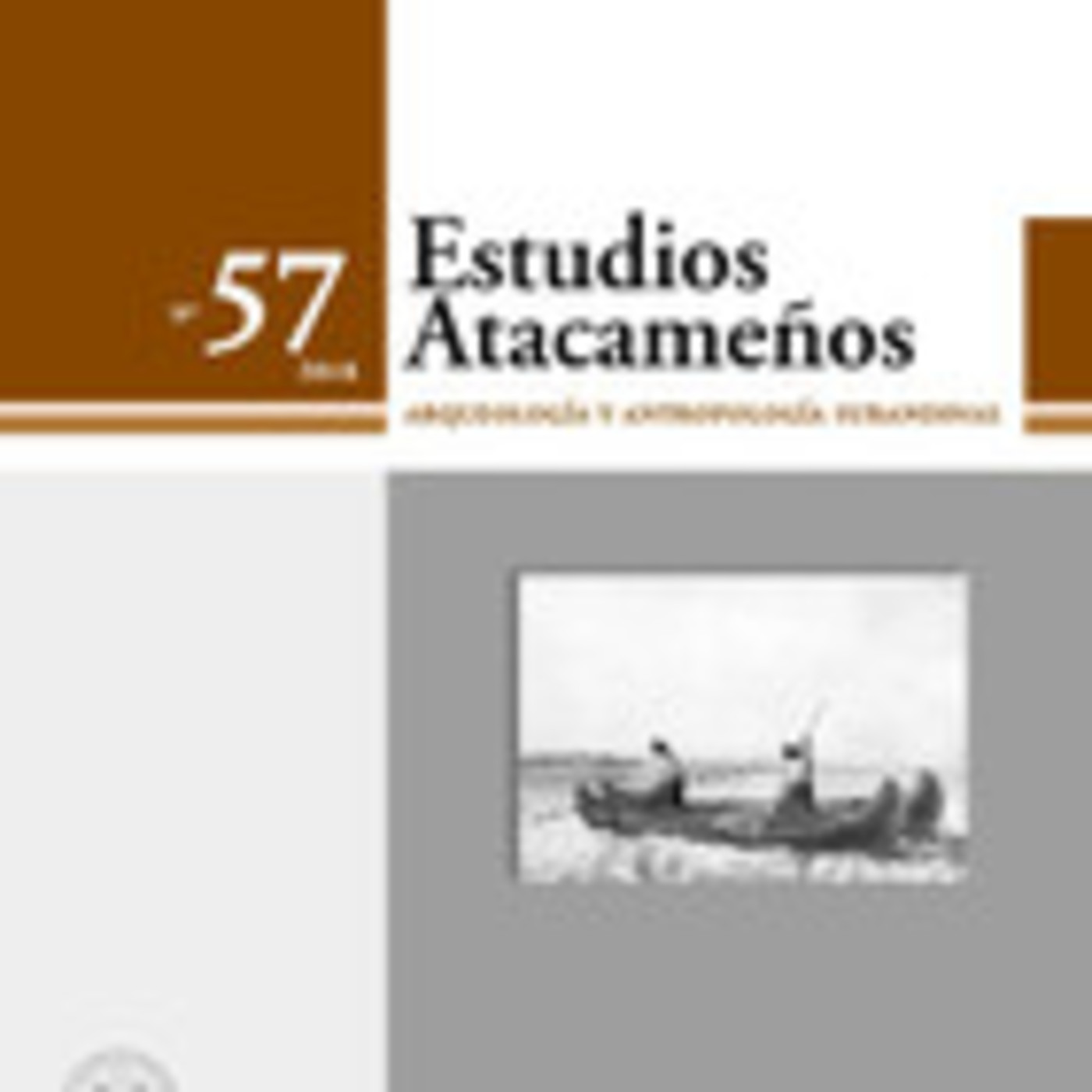 Estudios AtacameñosHarpoon technology in the Atacama desert coast, northern Chile.Author: Benjamín Ballester R.
Marine hunting was an essential activity in the way of life of the Atacama Desert littoral inhabitants, at northern Chile. A pillar in their social structure that was based in the material means to realize it, as boats and their sophisticated harpoon device, resting in the last the possibility of capture and drag main land preys that substantially out weigh the hunter. Currently the knowledge of harpooning is scarce in archaeology. For this reason we will delvein their morphology, composition, technical qualities, instrumental diversity, and chronology from a 129 harpoon heads sample from different prehistoric periods (6500 c...2019-01-2401 min
Estudios AtacameñosHarpoon technology in the Atacama desert coast, northern Chile.Author: Benjamín Ballester R.
Marine hunting was an essential activity in the way of life of the Atacama Desert littoral inhabitants, at northern Chile. A pillar in their social structure that was based in the material means to realize it, as boats and their sophisticated harpoon device, resting in the last the possibility of capture and drag main land preys that substantially out weigh the hunter. Currently the knowledge of harpooning is scarce in archaeology. For this reason we will delvein their morphology, composition, technical qualities, instrumental diversity, and chronology from a 129 harpoon heads sample from different prehistoric periods (6500 c...2019-01-2401 min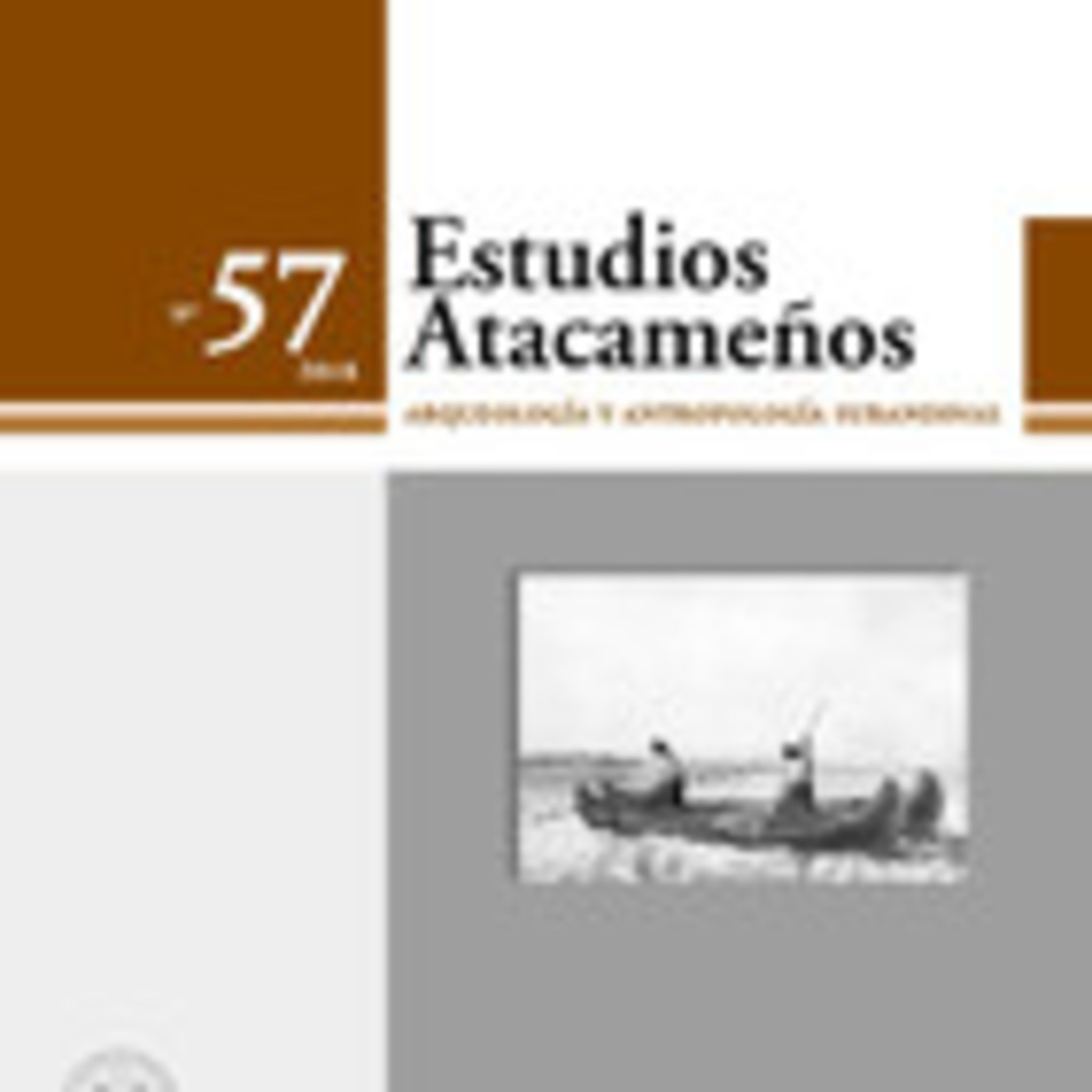 Estudios AtacameñosAgrarian landscape of the second millennium in the northern area of Tafi Valley (Tucumán, Argentina)Authors: Valeria Franco Salvi, Rocío María Molar.
This paper proposes to discuss the results of archaeological research carried out in the northern sector of the Tafi valley, specifically focusing on evidences corresponding to the first half of the Second Millennium of the Christian Age. During this period,the agrarian landscape is segregating of house hold area which has generated several explanations in the archaeological literature of the Northwest Argentina. We came to the preliminary conclusion that the valley acquires a spatial logic, typical of this periodin the region, but would not have been caused by factors that traditional ar...2019-01-2401 min
Estudios AtacameñosAgrarian landscape of the second millennium in the northern area of Tafi Valley (Tucumán, Argentina)Authors: Valeria Franco Salvi, Rocío María Molar.
This paper proposes to discuss the results of archaeological research carried out in the northern sector of the Tafi valley, specifically focusing on evidences corresponding to the first half of the Second Millennium of the Christian Age. During this period,the agrarian landscape is segregating of house hold area which has generated several explanations in the archaeological literature of the Northwest Argentina. We came to the preliminary conclusion that the valley acquires a spatial logic, typical of this periodin the region, but would not have been caused by factors that traditional ar...2019-01-2401 min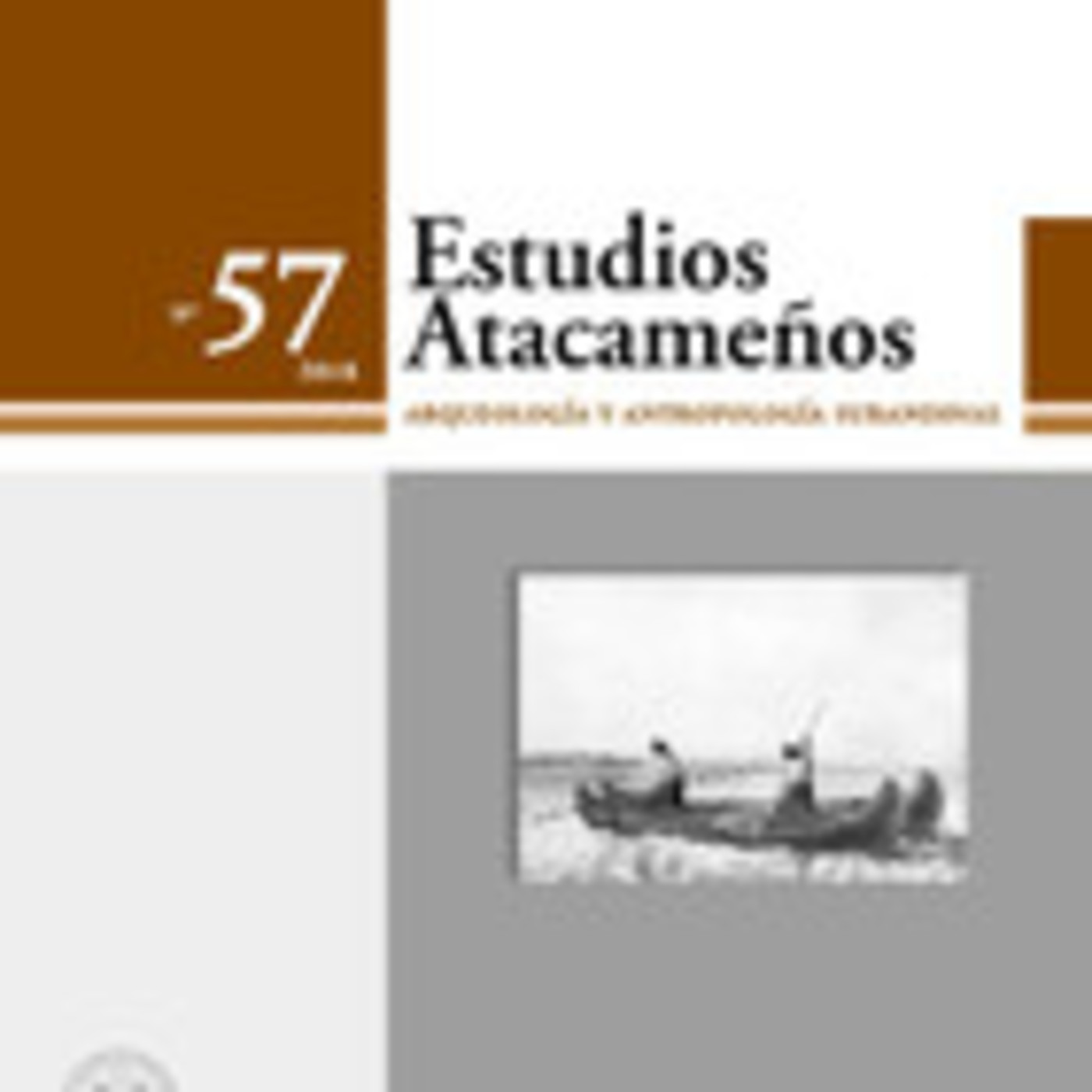 Estudios AtacameñosArchitecture and materiality of social interaction in the village community of Chañarcito, Los Molinos, La RiojaAuthors: Pablo Cahiza, María Lourdes Iniesta Di Cesare, Gabriela Sabatini, María José Ots.
In this paper we propose an approach that combines perspectives on the spatiality and the materiality of the Chañarcito village community, La Rioja (600 to 800 AD). Our focus generates information on the social landscape in the eastern foothills of the Velasco Mountains, and supports the emergence of reproduction of socio-political inequalities mechanisms and practices of social interaction, represented in the construction of public spaces –platform– and the differential consumption of ceramic objects. The identification of shared uses of architectural pattern,constructive technologies and ceramic styles, contribu...2019-01-2401 min
Estudios AtacameñosArchitecture and materiality of social interaction in the village community of Chañarcito, Los Molinos, La RiojaAuthors: Pablo Cahiza, María Lourdes Iniesta Di Cesare, Gabriela Sabatini, María José Ots.
In this paper we propose an approach that combines perspectives on the spatiality and the materiality of the Chañarcito village community, La Rioja (600 to 800 AD). Our focus generates information on the social landscape in the eastern foothills of the Velasco Mountains, and supports the emergence of reproduction of socio-political inequalities mechanisms and practices of social interaction, represented in the construction of public spaces –platform– and the differential consumption of ceramic objects. The identification of shared uses of architectural pattern,constructive technologies and ceramic styles, contribu...2019-01-2401 min Estudios AtacameñosCollection and handling of native forest resources, especially from algarrobo (Prosopis sp.) in the region of Fiambalá..Authors: Diego Andreoni, Bernarnda Marconetto, Verónica A. Mors, Norma Ratto.
Management process, selection and use of woody resources in the region of Fiambalá (Department Tinogasta, Catamarca) is evaluated, both by the populations who inhabited the region throughout the first millennium of the era as the Inca. The anthracological analysis of charcoals from archaeological sites in different contexts (residential and productive), which are located in different sectors and altitudes in the region (1500-1900 masl) was performed. The results show intensive use of algarrobo (Prosopis sp.) in combination with others speciesthroughout the period considered. Besides, we relate and contextualize the results wi...2019-01-2401 min
Estudios AtacameñosCollection and handling of native forest resources, especially from algarrobo (Prosopis sp.) in the region of Fiambalá..Authors: Diego Andreoni, Bernarnda Marconetto, Verónica A. Mors, Norma Ratto.
Management process, selection and use of woody resources in the region of Fiambalá (Department Tinogasta, Catamarca) is evaluated, both by the populations who inhabited the region throughout the first millennium of the era as the Inca. The anthracological analysis of charcoals from archaeological sites in different contexts (residential and productive), which are located in different sectors and altitudes in the region (1500-1900 masl) was performed. The results show intensive use of algarrobo (Prosopis sp.) in combination with others speciesthroughout the period considered. Besides, we relate and contextualize the results wi...2019-01-2401 min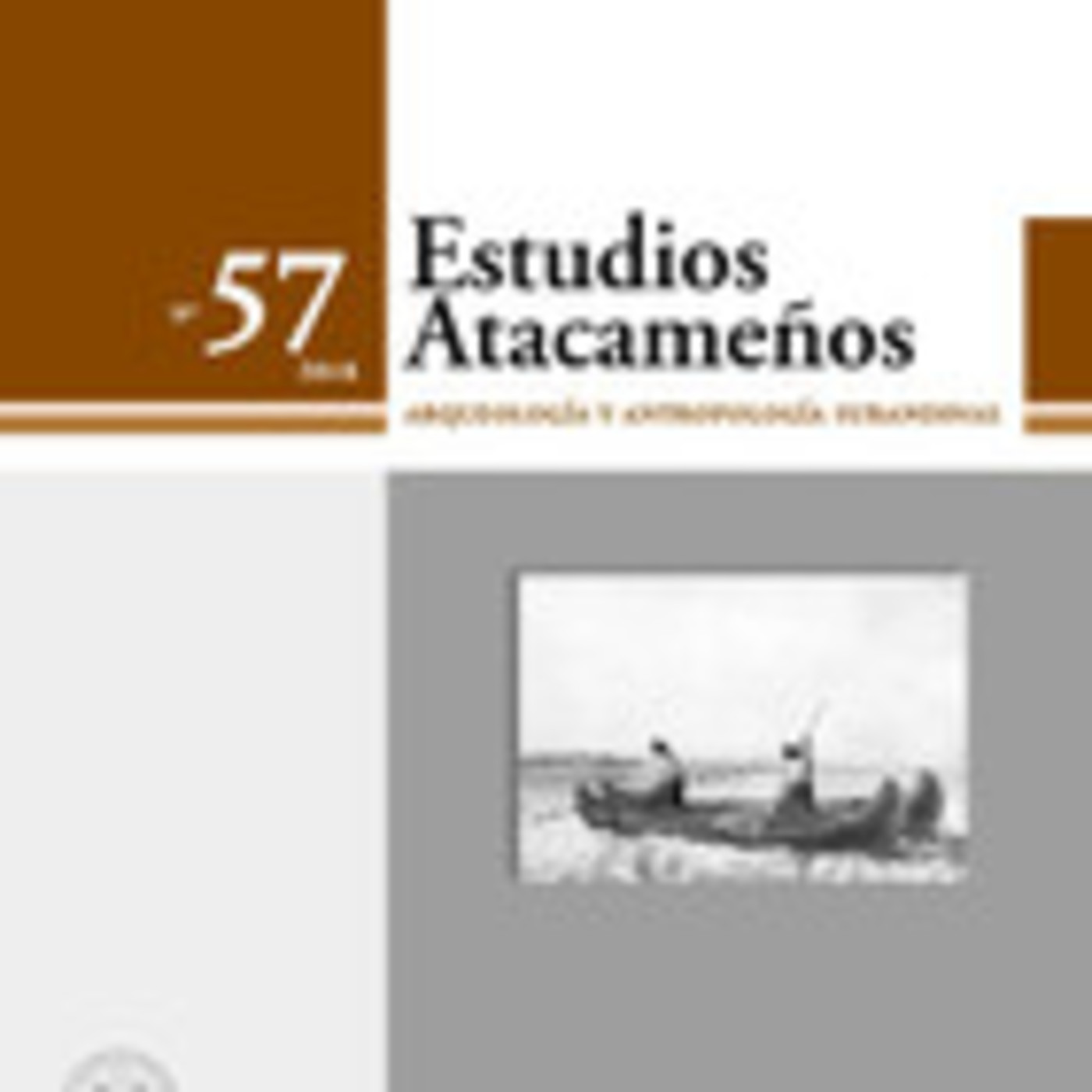 Estudios AtacameñosArquitectura y materialidad de la interacción social en la comunidad aldeana del Chañarcito, Los Molinos, La RiojaAutoras-es:
Pablo Cahiza, María Lourdes Iniesta Di Cesare, Gabriela Sabatini, María José Ots.
En este artículo proponemos un acercamiento que combina miradas sobre la espacialidad y la materialidad de la comunidad aldeana del Chañarcito, La Rioja (600 al 800 DC). Nuestro enfoque genera información sobre los paisajes sociales en el piedemonte oriental de la Sierra de Velasco, postulando el surgimiento de mecanismos de reproducción de desigualdades sociopolíticas y prácticas de interacción social, representado en la construcción de espacios públicos –plataforma– y en el consumo diferencial de objetos cerámicos. La identificación de usos comparti...2018-12-0701 min
Estudios AtacameñosArquitectura y materialidad de la interacción social en la comunidad aldeana del Chañarcito, Los Molinos, La RiojaAutoras-es:
Pablo Cahiza, María Lourdes Iniesta Di Cesare, Gabriela Sabatini, María José Ots.
En este artículo proponemos un acercamiento que combina miradas sobre la espacialidad y la materialidad de la comunidad aldeana del Chañarcito, La Rioja (600 al 800 DC). Nuestro enfoque genera información sobre los paisajes sociales en el piedemonte oriental de la Sierra de Velasco, postulando el surgimiento de mecanismos de reproducción de desigualdades sociopolíticas y prácticas de interacción social, representado en la construcción de espacios públicos –plataforma– y en el consumo diferencial de objetos cerámicos. La identificación de usos comparti...2018-12-0701 min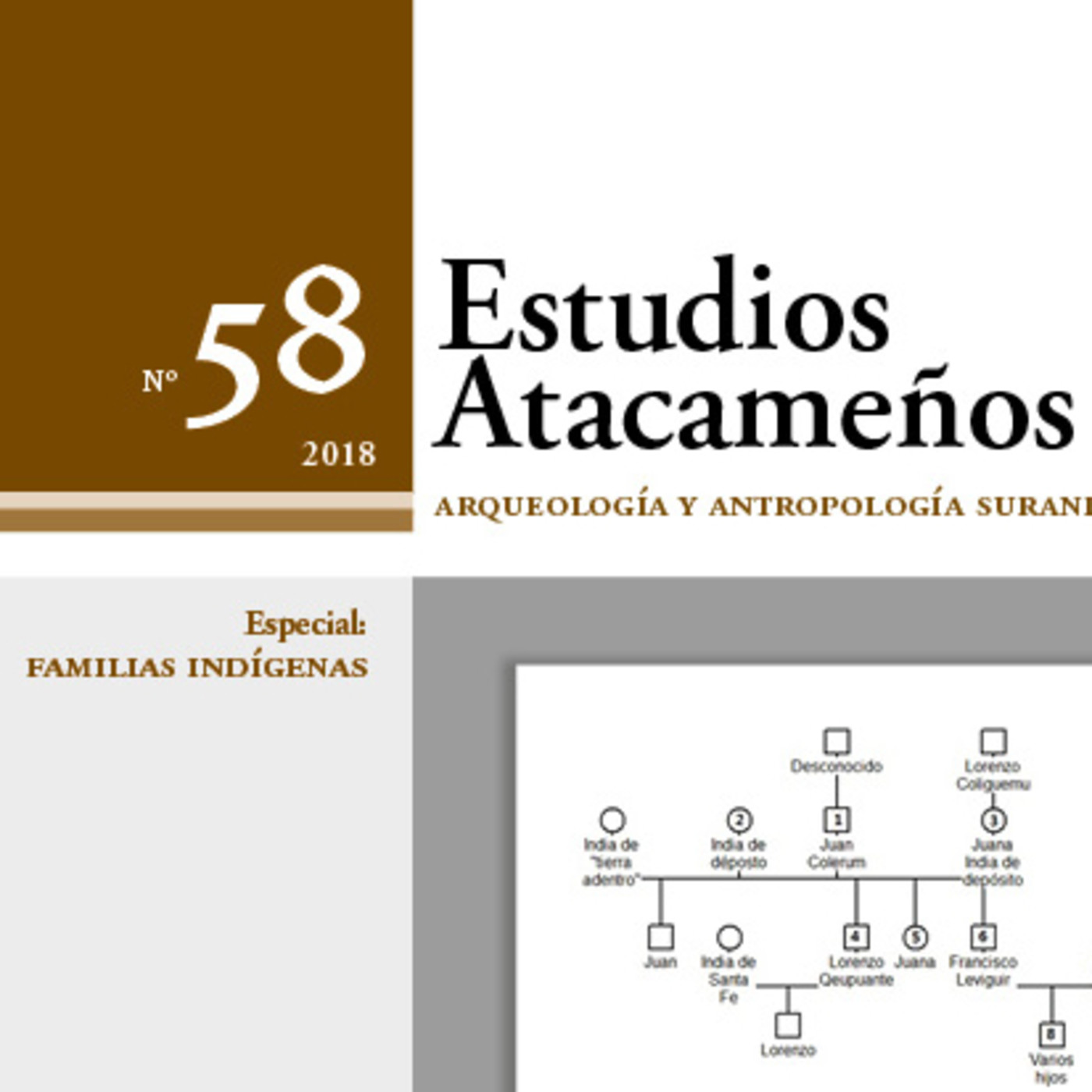 Estudios AtacameñosHistoria arquitectónica de Tarapacá: estrategias residenciales y formación de asentamientos, Siglos X AC a XVII DC...Autores:
Simón Urbina A., Leonor Adán A., Constanza Pellegrino H., Roberto Izaurieta S. J.
El presente trabajo sintetiza el estudio de patrones arquitectónicos residenciales y asentamientos para la región de Tarapacá entre los siglos X AC y XVII DC. La distribución, variabilidad y transformaciones de los sitios expresa una tendencia en donde los patrones formales de las estructuras domésticas resultan indicadores de cambios graduales o radicales en la organización/estructura social de las comunidades tarapaqueñas durante el período Formativo, Intermedio Tardío e Inca-Colonial. La propuesta teórica y el análisis hacen c...2018-11-1601 min
Estudios AtacameñosHistoria arquitectónica de Tarapacá: estrategias residenciales y formación de asentamientos, Siglos X AC a XVII DC...Autores:
Simón Urbina A., Leonor Adán A., Constanza Pellegrino H., Roberto Izaurieta S. J.
El presente trabajo sintetiza el estudio de patrones arquitectónicos residenciales y asentamientos para la región de Tarapacá entre los siglos X AC y XVII DC. La distribución, variabilidad y transformaciones de los sitios expresa una tendencia en donde los patrones formales de las estructuras domésticas resultan indicadores de cambios graduales o radicales en la organización/estructura social de las comunidades tarapaqueñas durante el período Formativo, Intermedio Tardío e Inca-Colonial. La propuesta teórica y el análisis hacen c...2018-11-1601 min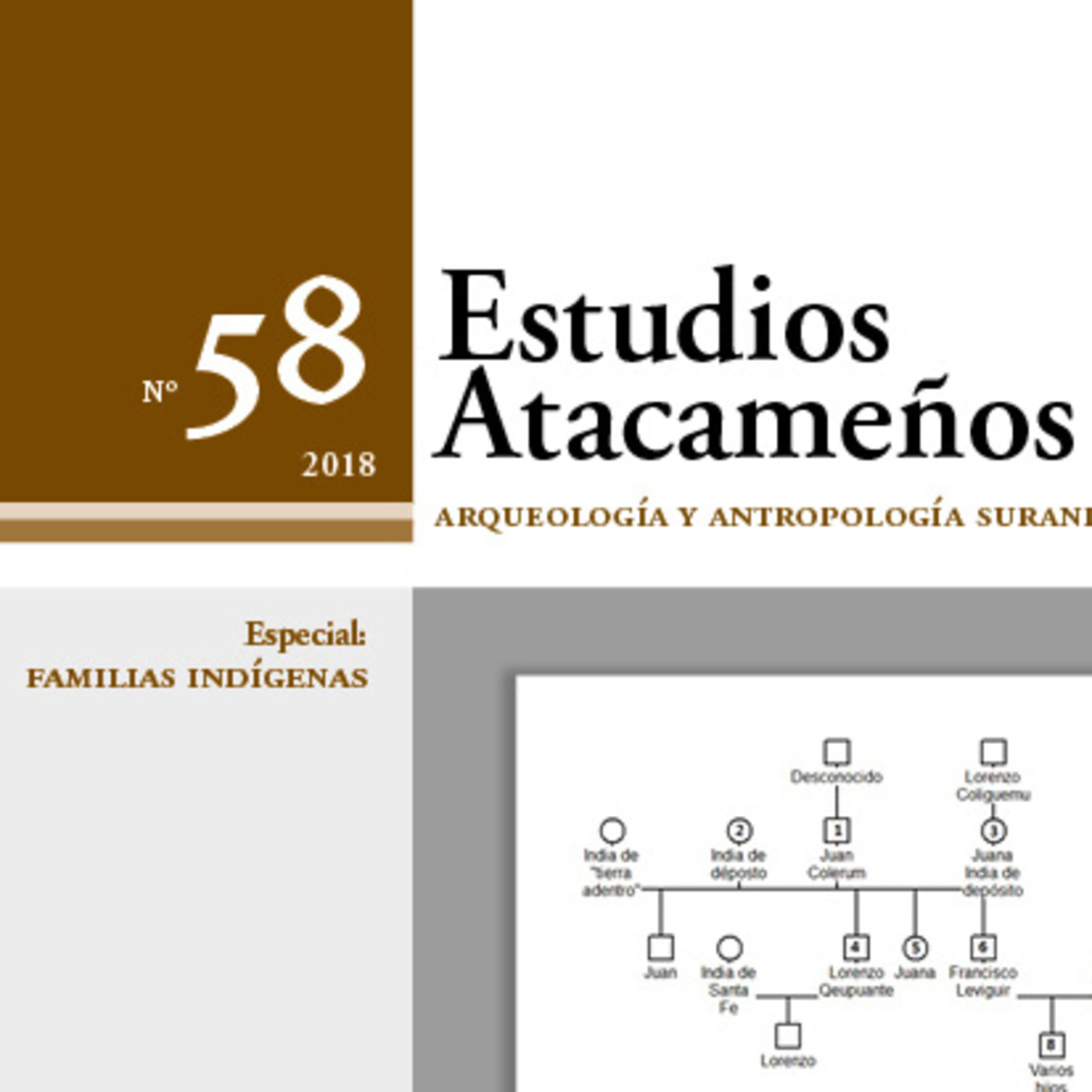 Estudios AtacameñosComplementariedad de métodos y fuentes en el estudio histórico de familias indígenas (Belén, Altos de Arica, 1750-1820)Autor:
Xochitl G. Inostroza Ponce
La reconstitución de familias del pueblo de Belén me ha permitido acceder a aspectos demográficos escasamente estudiados en poblaciones andinas, pero también a otros fenómenos cualitativos que permiten un análisis histórico de aspectos relativos al matrimonio y el parentesco. Contar con una gran cantidad de fuentes y archivos de distinta naturaleza ha desarrollado las potencialidades metodológicas, dando acceso a la comparación de resultados a partir de los distintos documentos, promoviendo una visión crítica del análisis individual de cada una de las fuentes, así como de los r...2018-11-1601 min
Estudios AtacameñosComplementariedad de métodos y fuentes en el estudio histórico de familias indígenas (Belén, Altos de Arica, 1750-1820)Autor:
Xochitl G. Inostroza Ponce
La reconstitución de familias del pueblo de Belén me ha permitido acceder a aspectos demográficos escasamente estudiados en poblaciones andinas, pero también a otros fenómenos cualitativos que permiten un análisis histórico de aspectos relativos al matrimonio y el parentesco. Contar con una gran cantidad de fuentes y archivos de distinta naturaleza ha desarrollado las potencialidades metodológicas, dando acceso a la comparación de resultados a partir de los distintos documentos, promoviendo una visión crítica del análisis individual de cada una de las fuentes, así como de los r...2018-11-1601 min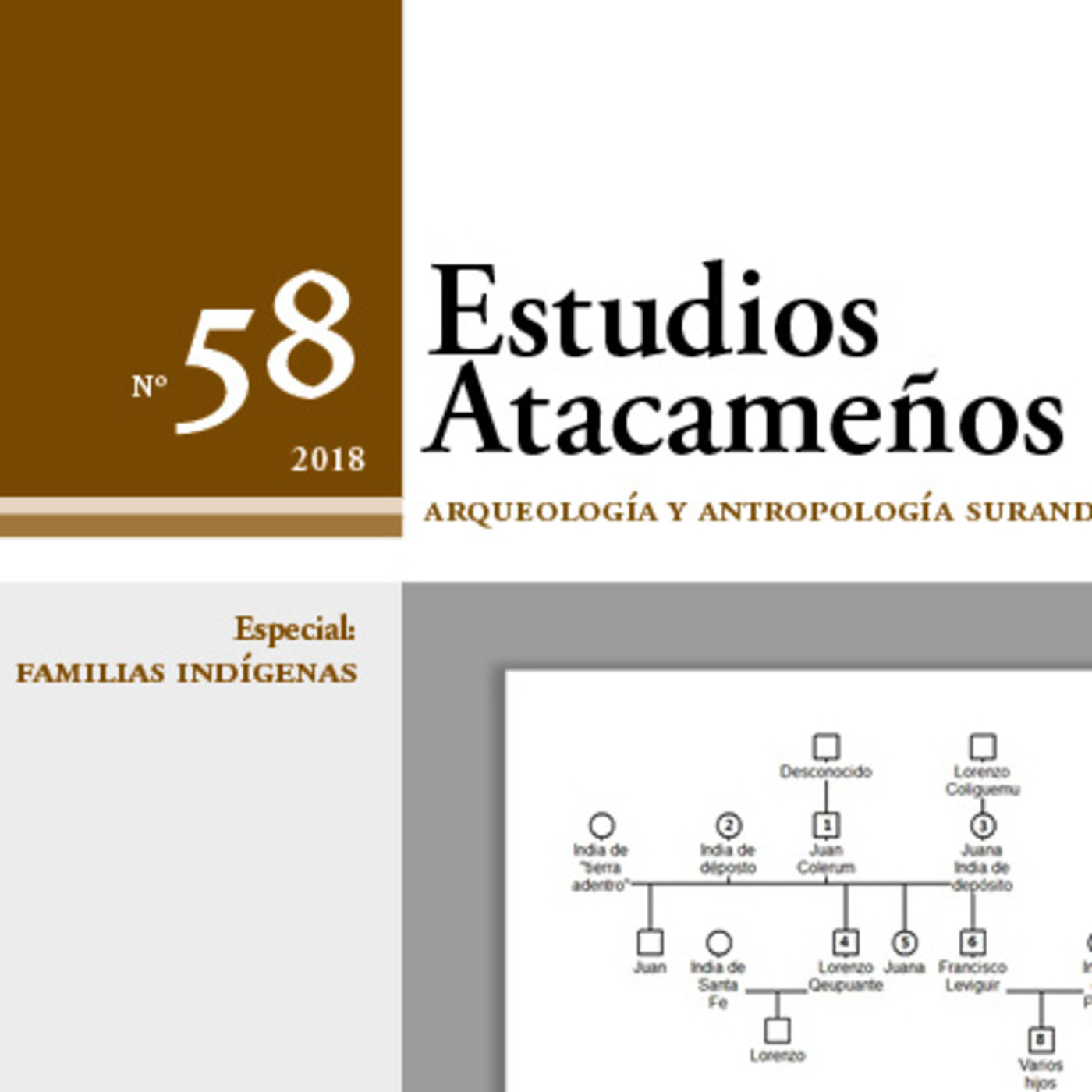 Estudios AtacameñosPrácticas y categorías de parentesco en Jasimaná, noroeste andino de ArgentinaAutora: Daniela Salvucci
Pese a la difusión de la ideología genealógica española y del modelo católico de unión y descendencia legítima que se dio a partir de la colonización, en la Argentina andina existieron y siguen existiendo “culturas” indígenas de “familia” y “parentesco”. El objetivo del texto es analizar, desde una perspectiva de la antropología cultural, las categorías émicas y las prácticas del parentesco en el altiplano de Jasimaná (provincia de Salta, Noroeste de Argentina, NOA). El método etnográfico y el estudio de caso, a partir de reconstrucciones gráficas...2018-11-1600 min
Estudios AtacameñosPrácticas y categorías de parentesco en Jasimaná, noroeste andino de ArgentinaAutora: Daniela Salvucci
Pese a la difusión de la ideología genealógica española y del modelo católico de unión y descendencia legítima que se dio a partir de la colonización, en la Argentina andina existieron y siguen existiendo “culturas” indígenas de “familia” y “parentesco”. El objetivo del texto es analizar, desde una perspectiva de la antropología cultural, las categorías émicas y las prácticas del parentesco en el altiplano de Jasimaná (provincia de Salta, Noroeste de Argentina, NOA). El método etnográfico y el estudio de caso, a partir de reconstrucciones gráficas...2018-11-1600 min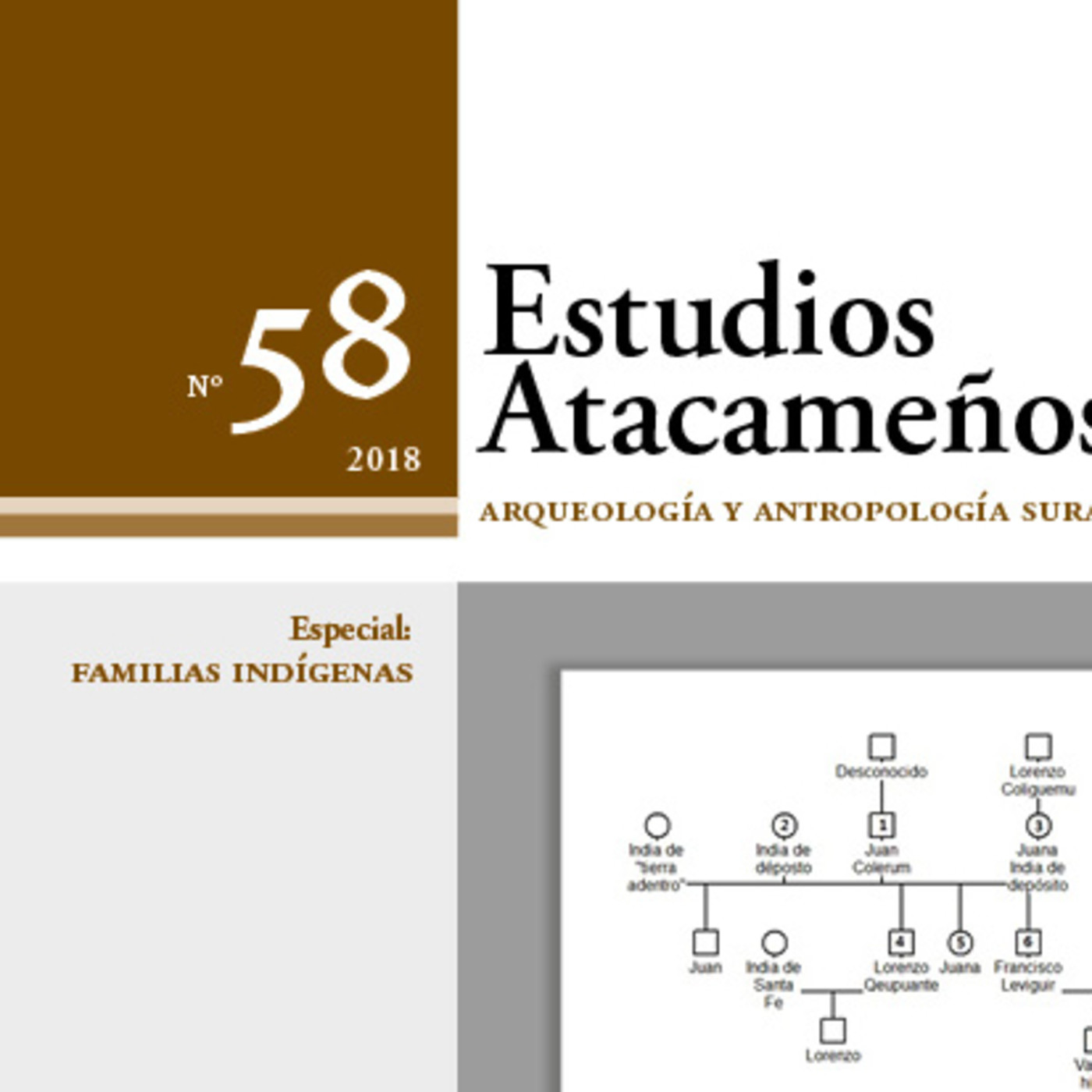 Estudios Atacameños“Santa Fe mo (inche ñi mapu mo cay)”. Vida familiar en la reducción fronteriza de Santa Fe, Chile (Siglo XVIII)Autor:
Ignacio Chuecas Saldías
Este artículo explora aspectos característicos en la conformación y articulación de las familias mapuche asentadas en la reducción fronteriza de Santa Fe (Chile) durante el siglo XVIII. Santa Fe, al igual que el resto de las reducciones emplazadas a orillas del río Biobío, representaba un espacio negociado donde las familias indígenas, que en ella residieron, desplegaron estrategias de naturaleza híbrida a fin de conservar y acrecentar su capacidad de agencia al interior del sistema colonial hispano. Entre estas estrategias resulta posible considerar los peculiares sistemas de asentamien...2018-11-1601 min
Estudios Atacameños“Santa Fe mo (inche ñi mapu mo cay)”. Vida familiar en la reducción fronteriza de Santa Fe, Chile (Siglo XVIII)Autor:
Ignacio Chuecas Saldías
Este artículo explora aspectos característicos en la conformación y articulación de las familias mapuche asentadas en la reducción fronteriza de Santa Fe (Chile) durante el siglo XVIII. Santa Fe, al igual que el resto de las reducciones emplazadas a orillas del río Biobío, representaba un espacio negociado donde las familias indígenas, que en ella residieron, desplegaron estrategias de naturaleza híbrida a fin de conservar y acrecentar su capacidad de agencia al interior del sistema colonial hispano. Entre estas estrategias resulta posible considerar los peculiares sistemas de asentamien...2018-11-1601 min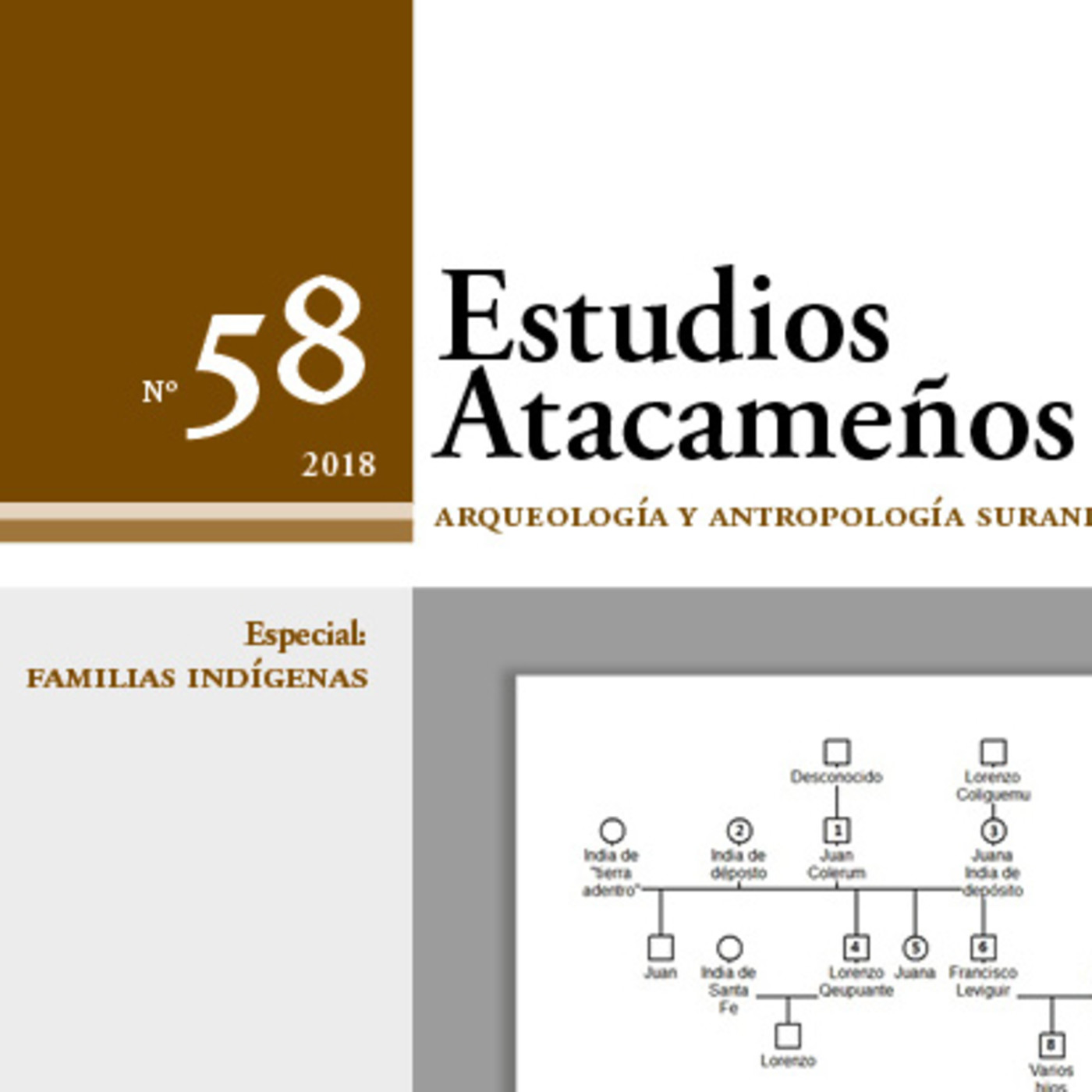 Estudios AtacameñosComposiciones familiares y configuraciones matrimoniales en redes genealógicas indígenas del oriente jujeño, Siglo XIXAutor:
Juan Pablo Ferreiro
Gregory Bateson propone como objeto y fin de sus reflexiones en Espíritu y Naturaleza la noción de “pauta que conecta”, a través de preguntas tales como ¿cuál es la pauta que conecta a todas las criaturas vivientes? Hemos escogido, como objeto de nuestro análisis, en cambio, una dimensión fractal de aquella propuesta, restringida a los vínculos desarrollados en los campos nucleares de la reproducción sociocultural. Nuestro interés es reconocer y analizar las configuraciones de algunos vínculos de parentesco y la ocupación que hace de una región delimitad...2018-11-1601 min
Estudios AtacameñosComposiciones familiares y configuraciones matrimoniales en redes genealógicas indígenas del oriente jujeño, Siglo XIXAutor:
Juan Pablo Ferreiro
Gregory Bateson propone como objeto y fin de sus reflexiones en Espíritu y Naturaleza la noción de “pauta que conecta”, a través de preguntas tales como ¿cuál es la pauta que conecta a todas las criaturas vivientes? Hemos escogido, como objeto de nuestro análisis, en cambio, una dimensión fractal de aquella propuesta, restringida a los vínculos desarrollados en los campos nucleares de la reproducción sociocultural. Nuestro interés es reconocer y analizar las configuraciones de algunos vínculos de parentesco y la ocupación que hace de una región delimitad...2018-11-1601 min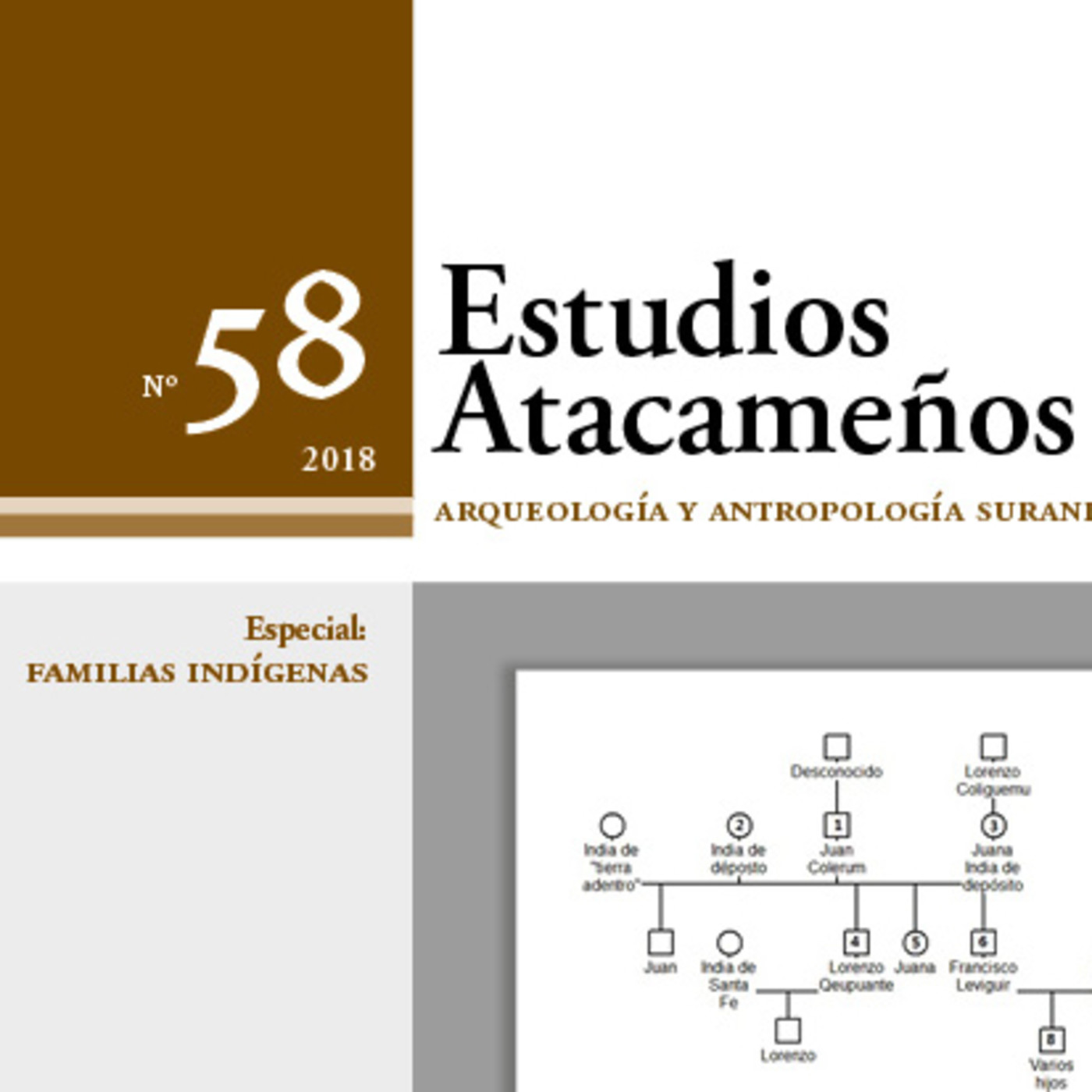 Estudios AtacameñosRedes de capital social familiar en la región oriental de Jujuy (Argentina) durante las tres primeras décadas del sigloAutor: Federico Fernández.
En esta investigación se analiza la utilización de la categoría capital social, y sus vinculaciones posibles con los procesos de acumulación relacional y movilidad espacial entre familias extensas con residencias múltiples dentro de la región oriental de la provincia de Jujuy. La principal fuente de información con la que se ha elaborado el trabajo proviene de un conjunto de actas bautismales realizadas entre los años 1902 y 1935 por sacerdotes de la Prelatura de Humahuaca de Jujuy, sobre la población residente en la región conocida como Valle Grande. Los resulta...2018-11-1501 min
Estudios AtacameñosRedes de capital social familiar en la región oriental de Jujuy (Argentina) durante las tres primeras décadas del sigloAutor: Federico Fernández.
En esta investigación se analiza la utilización de la categoría capital social, y sus vinculaciones posibles con los procesos de acumulación relacional y movilidad espacial entre familias extensas con residencias múltiples dentro de la región oriental de la provincia de Jujuy. La principal fuente de información con la que se ha elaborado el trabajo proviene de un conjunto de actas bautismales realizadas entre los años 1902 y 1935 por sacerdotes de la Prelatura de Humahuaca de Jujuy, sobre la población residente en la región conocida como Valle Grande. Los resulta...2018-11-1501 min